by Geoff Burch
Welcome to the third page of BR Southern Region Memories, featuring another batch of previously unpublished images from the photographic collections of Rail-Cameramen Alex (Mac) McCIymont and Dave Salmon. Plus there are a number of additional photos from the collections of Mike Morant, Norman Hamshere, Brian Davey, Colin Stacey, David Christie and Austin Attewell, and I'm pleased to include another round of Pat Kinsella's quirky stories - if you can call a near-fatal shooting on the footplate and a runaway electric train quirky that is!
(Below) The 50th Anniversary of the closure of Guildford Motive Power Depot and the end of steam on the Southern Region. Retired railwaymen and steam fans gathered on Farnham Road bridge on Sunday morning, July 9 2017, for the unveiling of a plaque by Richard Greenwood MBE to commemorate Guildford engine shed which closed exactly 50 years ago. Further details can be found on page 32.
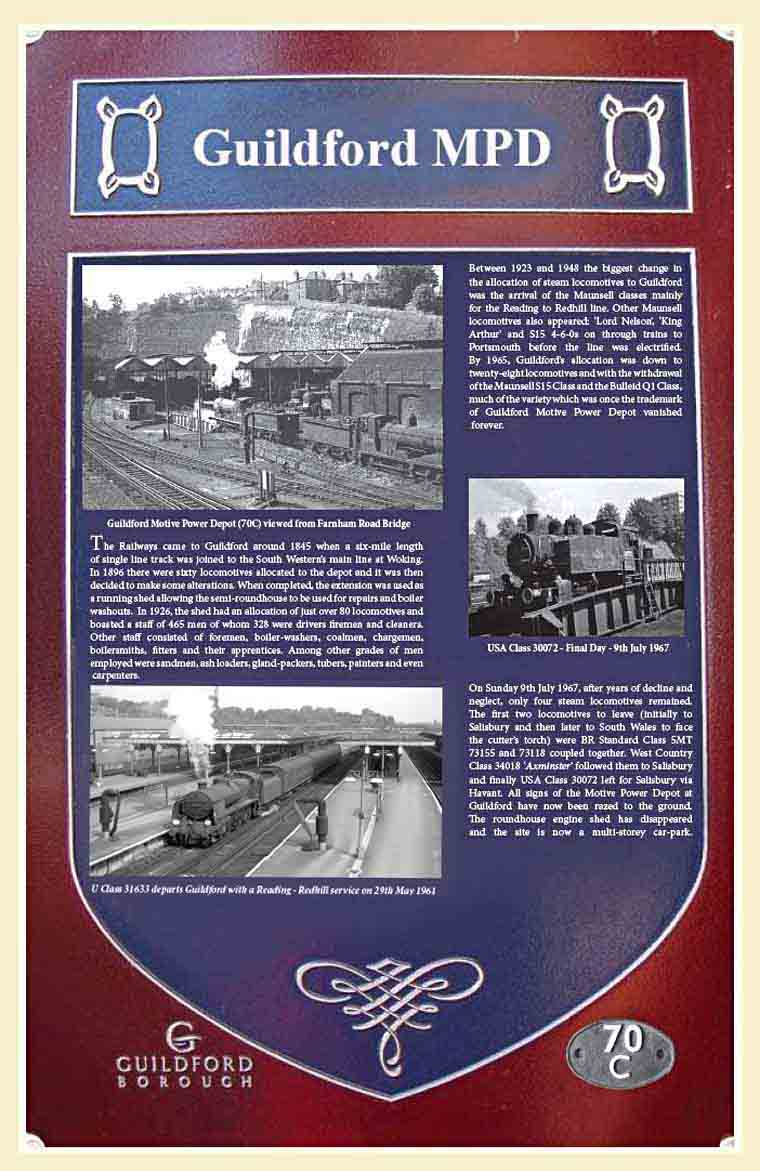
Putting this page together has rekindled a lot of old memories of Nine Elms, Eastleigh and Guildford depots - all of which I worked at during my time on the footplate, and every one of which went into gradual decline towards the end of steam days. So too did the locomotives that graced these depots - once-proud gleaming machines facing their final years in a deplorable state of disrepair due to neglect.
In fact the headlong rush to abandon steam was an absolute travesty as some of the new BR Standard Class locomotives were regarded as no longer fit for purpose and scrapped after serving less than 10 years in service - a massive lack of forethought...
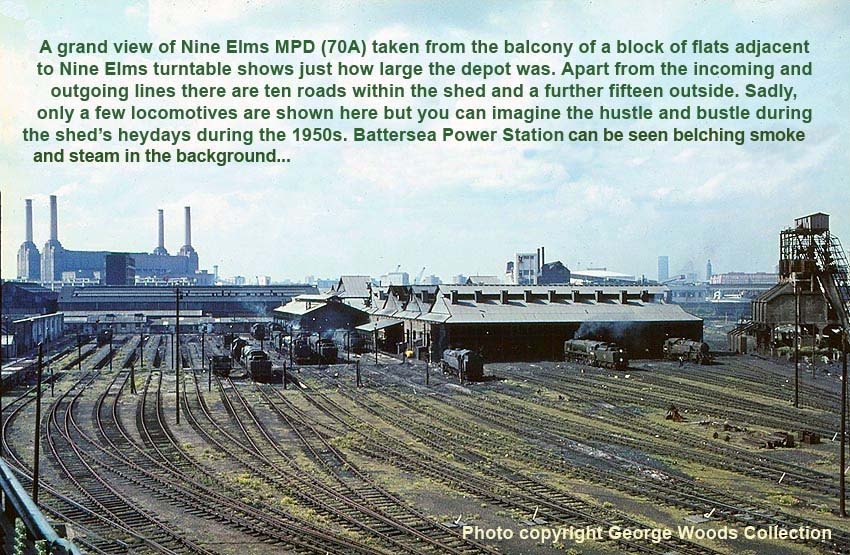
(Above-Inset-Below) A grand view of Nine Elms MPD taken from the balcony of a block of flats adjacent to Nine Elms turntable shows just how large the depot was. Apart from the incoming and outgoing lines there are ten roads within the shed and a further fifteen outside. Sadly, only a few locomotives are shown here but you can imagine the hustle and bustle during the shed's heyday in the 1950s. Battersea Power Station with its four corner chimneys in brick cathedral style dominates the skyline; it is the largest brick built building in Europe. (Inset) A cast iron street name, 'Nine Elms Lane SW' with scalloped corners and in original condition, went under the hammer for £520 at a Sheffield Railwayana Auction in September 2008.
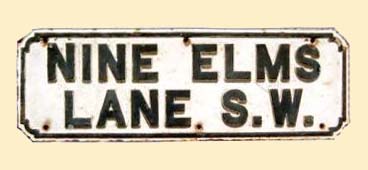 The sign was removed from the wall surrounding the depot when it was being demolished to make way for the new Covent Garden Market in the early 1970s. (Below) BR Standard Class 3MT 2-6-2T 82019 with bunker (and cab roof) fully loaded with coal is about to leave Nine Elms for Waterloo for a day's work on empty coaching stock (ECS) between Waterloo and Clapham Yard on 24th March 1967. In the background can be seen Loco Junction Signalbox which spanned the running lines and controlled all movements in and out of Nine Elms MPD. Beyond it can be seen Battersea Power Station with chimneys belching smoke and steam.
The sign was removed from the wall surrounding the depot when it was being demolished to make way for the new Covent Garden Market in the early 1970s. (Below) BR Standard Class 3MT 2-6-2T 82019 with bunker (and cab roof) fully loaded with coal is about to leave Nine Elms for Waterloo for a day's work on empty coaching stock (ECS) between Waterloo and Clapham Yard on 24th March 1967. In the background can be seen Loco Junction Signalbox which spanned the running lines and controlled all movements in and out of Nine Elms MPD. Beyond it can be seen Battersea Power Station with chimneys belching smoke and steam.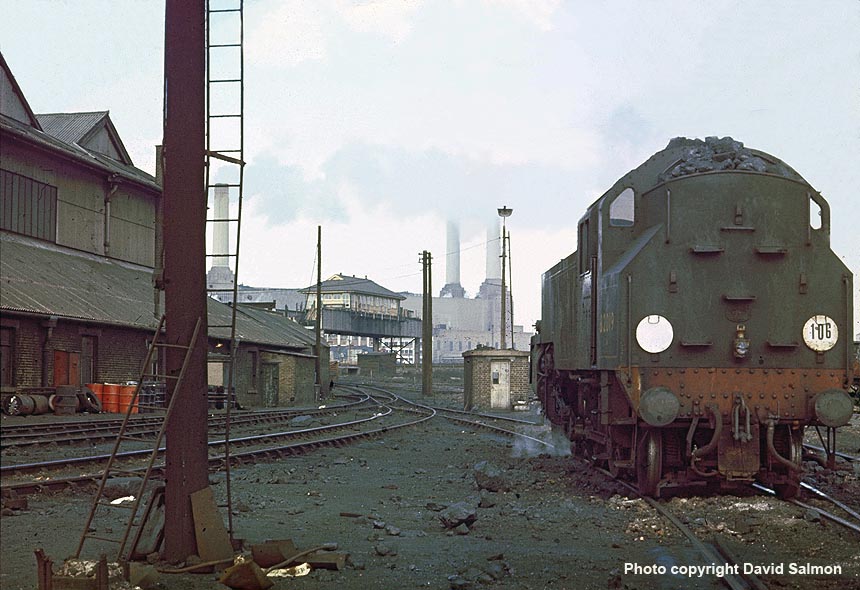

(Above-Below) From main line to country branch line services...as Pat Kinsella mentions in his stories below an engineman's life on the footplate was as diverse as they come! Here an unidentified West Country Class Pacific passes beneath Loco Junction Signalbox with a Boat train from Waterloo bound for Southampton New Docks; two locomotives (coupled together) drop down into Nine Elms MPD having been released from their respective trains at Waterloo. Locomotives were often booked to run coupled together to and from Waterloo to ease traffic congestion. On the left, a 350hp Diesel Shunting locomotive can be seen running light to Nine Elms Goods Yard. (Below) In complete contrast, BR Class 2-6-2T 84027 heads through unspoiled Surry countryside near Cranleigh with a Horsham-Guildord train on 28th August 1961.
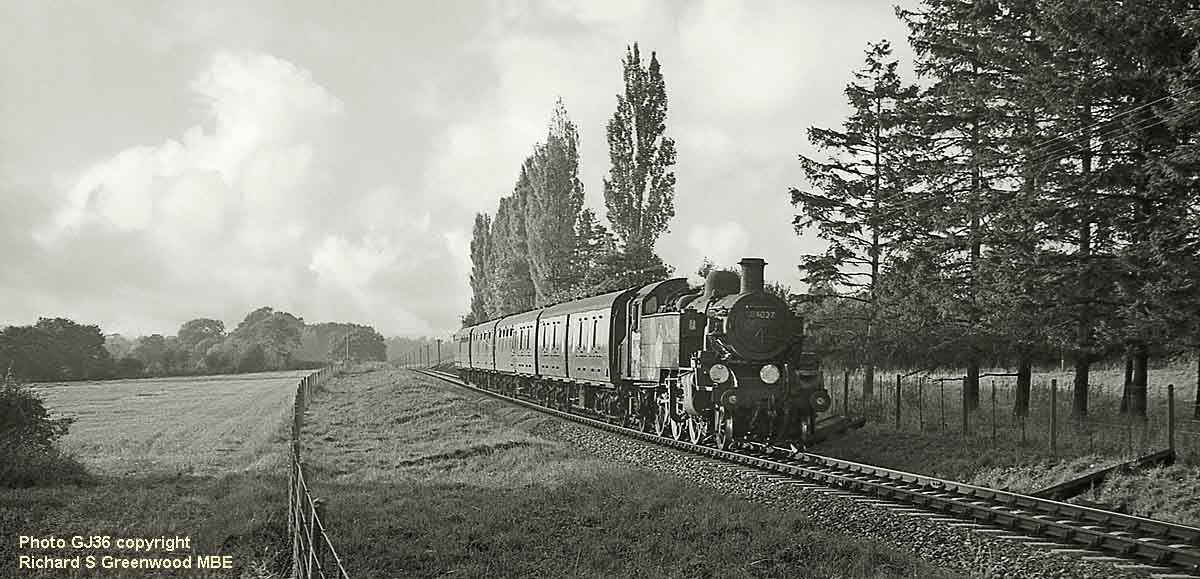
(Below) This interesting shot was sent to me by Mike Fracklewicz of the Maunsell Locomotive Society and shows U Class 31638 departing from platform 5 at Guildford with the 10.04 am passenger service to Redhill on the 26th April 1962. Waiting for its pathway, S15 Class 30847 stands at the signal on platform 2 with a stone train from Woking heading for the same destination and then on to either Three Bridges or Tonbridge. A quirk of fate became of these locomotives as they were both saved from the cutter's torch and are now in the safe hands of the Maunsell Locomotive Society Railway link here.
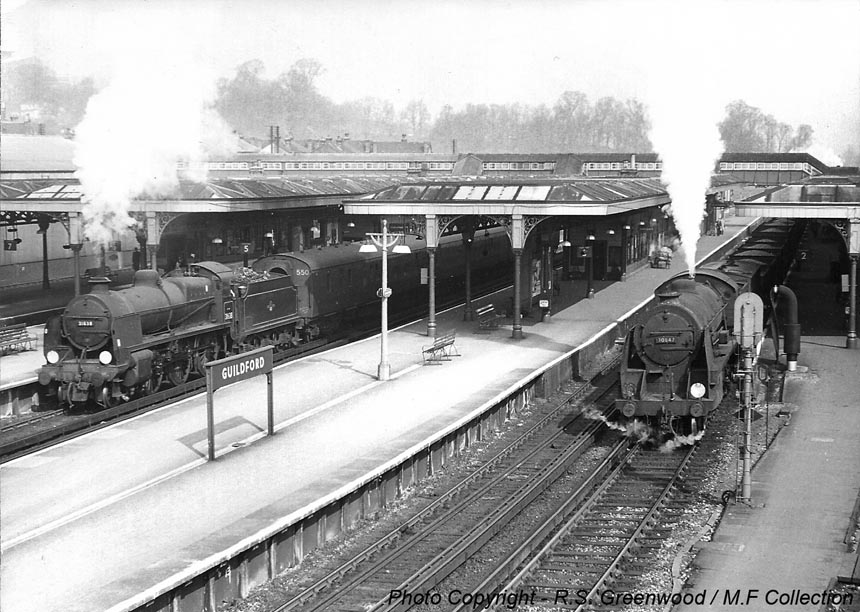
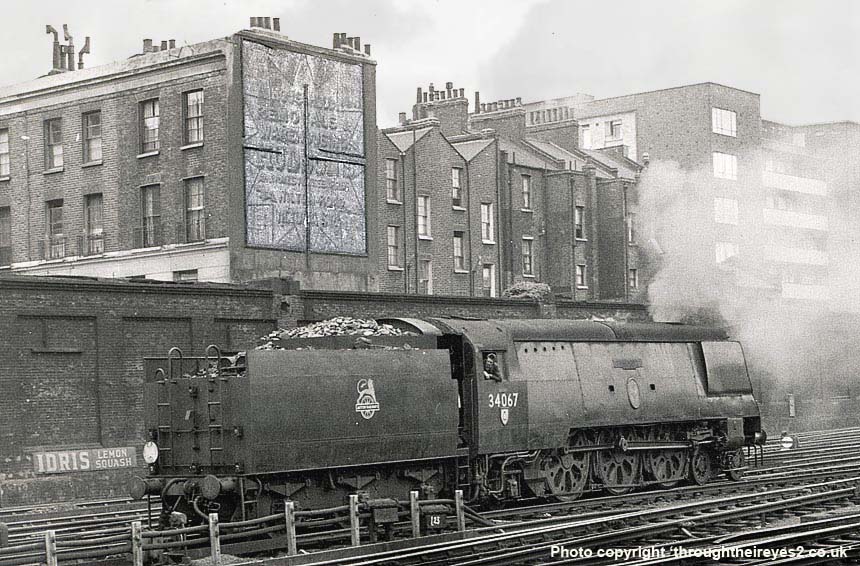
(Above-Insert Right-Below) Some of the 'Battle of Britain' class had additional embellishments to the standard livery, including No 34050 Royal Observer Corps which was presented with an ROC long-service medal by Commandant ROC Air Commodore Wight-Boycott at a ceremony held at Waterloo Station in July 1961. The locomotive's cabside was given a representation of the medal and its ribbon, which was displayed until the engine was withdrawn from service and scrapped in
 the late 1960s. The original nameplate and crest were recovered and displayed in the entrance hall of ROC Headquarters at RAF Bentley Priory until 1996 when it was transferred to the RAF Museum at Hendon. Another locomotive presented with a cabside crest was 34067 'Tangmere'. The loco was built in September 1947 at Brighton works as No 21C167. This was the continental numbering system as preferred by Oliver Bullied. The first part of the number - 21C - indicate the 4-6-2 'Pacific' wheel arrangement whereby the two leading axles are indicated by a '2', the one trailing axle by a '1' and the six driving wheels by the letter 'C'. The last three numbers indicate the series 1(00) 'Light Pacifics' of which Tangmere was the 67th built, hence the the number 167.
the late 1960s. The original nameplate and crest were recovered and displayed in the entrance hall of ROC Headquarters at RAF Bentley Priory until 1996 when it was transferred to the RAF Museum at Hendon. Another locomotive presented with a cabside crest was 34067 'Tangmere'. The loco was built in September 1947 at Brighton works as No 21C167. This was the continental numbering system as preferred by Oliver Bullied. The first part of the number - 21C - indicate the 4-6-2 'Pacific' wheel arrangement whereby the two leading axles are indicated by a '2', the one trailing axle by a '1' and the six driving wheels by the letter 'C'. The last three numbers indicate the series 1(00) 'Light Pacifics' of which Tangmere was the 67th built, hence the the number 167. Following the nationalisation of Britain's railways Tangmere was renumbered 34067 in July 1949. (Above) No 34067 is seen backing onto its train at London Victoria station during the late Fifties (Inset) The 'Royal Air Force' enamel crest was centrally positioned beneath her nameplate on the boiler casing, but thenameplate did not feature the airfield's crest. The RAF base at Tangmere was situated three miles from Chichester in Sussex and became one of the airfields used during the Battle of Britain in the 1940s. It was not until 1955 that the 'Tangmere' shield was added beneath the cab number. Here is a close up of the cabside crest on the now-preserved 34067.
(Below) Throughout 34067's career, the loco worked out of sheds at Stewarts Lane (London), Salisbury and finally Eastleigh, and after covering almost 700,000 miles in service, the loco was withdrawn on 16 November 1963. In April 1965 the loco was moved to Woodhams Scrapyard in Barry, South Wales, where she was rescued by the late Brian Pickett, who moved Tangmere to the Mid-Hants Railway in Hampshire for restoration.
However most of the restoration subsequently took place at the Ian Riley engineering works at Bury, Lancashire and in 2003 Tangmere was returned to steam on the East Lancs Railway. In March of that year Tangmere was returned to main line running and is regularly employed hauling steam specials, including the 'Scarborough Spa Express' seen here on the climb to Diggle on the outward leg to the Yorkshire coast.
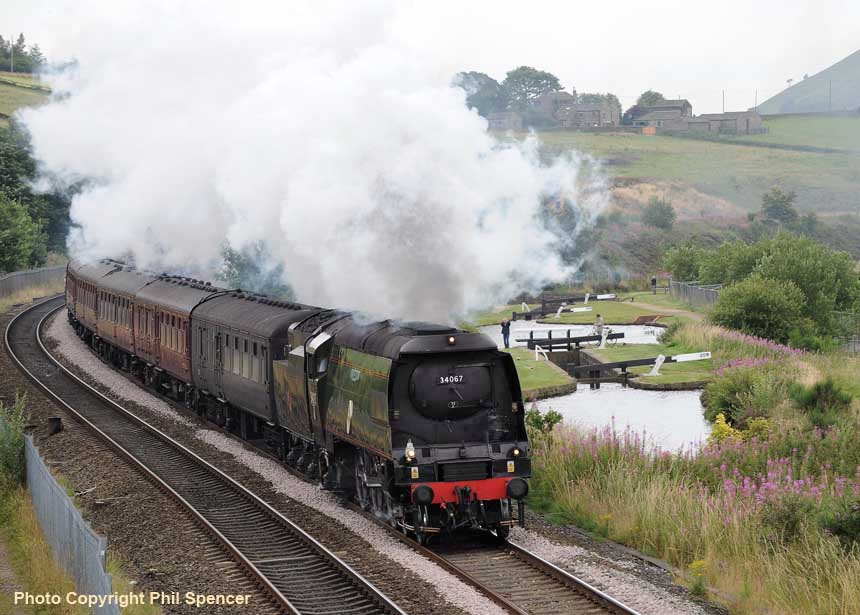
(Below) Rebuilt Battle of Britain Class 34059 'Sir Archibald Sinclair', Rebuilt West Country Class 34032 'Camelford' and Rebuilt Battle of Britain Class 34082 '615 Squadron' await their fate at Eastleigh MPD on 11th June 1966. A pair of type 3 Crompton Diesel-Electric locomotives stand nearby - two of the steam locomotive's fate are sealed - 34059 is preserved and can be seen working on the Bluebell Railway.
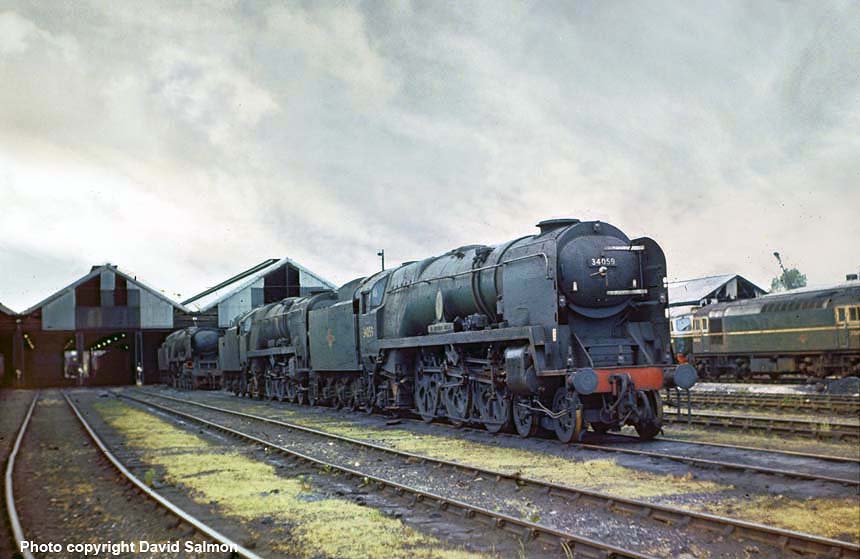

(Above-Right Insert-Below) BR Standard Class 4MT 75068 waits to be coaled at Guildford on 21st May 1967. Introduced in 1951 and designed at Brighton, 22 of the 80 members of this class were
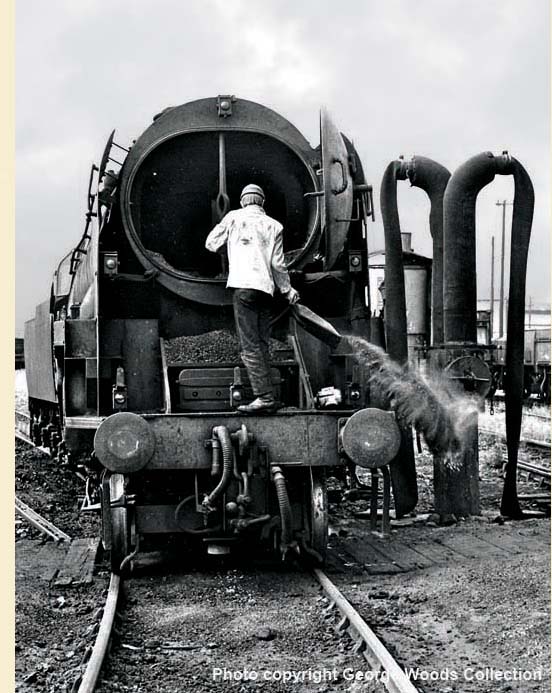 built in 1957 with a double chimney including 75068. (Right) A fireman cleans out the ash from the smokebox of an unidentified Rebuilt West Country Class locomotive at Nine Elms MPD. Sometimes, the ash could half fill the smokebox - and judging by the amount of ash spilt at the fireman's feet it would appear that this was such a case when he opened the smokebox door! (Below) I can think of numerous good points about the new BR Standard Class locomotives, especially from a fireman's point of view; the relative ease regarding disposal duties is one of them. When operating a rocking grate it allowed the accumulative deposits of clinker and ash to fall straight into the ash pit; this was much easier than the laborious task of dragging the clinker and ash out through the firehole door using a clinker shovel. Most BR Standard Class locomotives also had self cleaning smokeboxes, as indicated by an 'SC' plate beneath the shed number plate. Another creature comfort for the fireman and driver was their comfortable armchair type seats instead of the primitive drop down wooden slat seats found on the Urie and Maunsell locomotives. Sadly after only a 10 year working life, 75068 ended her days in July 1967.
built in 1957 with a double chimney including 75068. (Right) A fireman cleans out the ash from the smokebox of an unidentified Rebuilt West Country Class locomotive at Nine Elms MPD. Sometimes, the ash could half fill the smokebox - and judging by the amount of ash spilt at the fireman's feet it would appear that this was such a case when he opened the smokebox door! (Below) I can think of numerous good points about the new BR Standard Class locomotives, especially from a fireman's point of view; the relative ease regarding disposal duties is one of them. When operating a rocking grate it allowed the accumulative deposits of clinker and ash to fall straight into the ash pit; this was much easier than the laborious task of dragging the clinker and ash out through the firehole door using a clinker shovel. Most BR Standard Class locomotives also had self cleaning smokeboxes, as indicated by an 'SC' plate beneath the shed number plate. Another creature comfort for the fireman and driver was their comfortable armchair type seats instead of the primitive drop down wooden slat seats found on the Urie and Maunsell locomotives. Sadly after only a 10 year working life, 75068 ended her days in July 1967.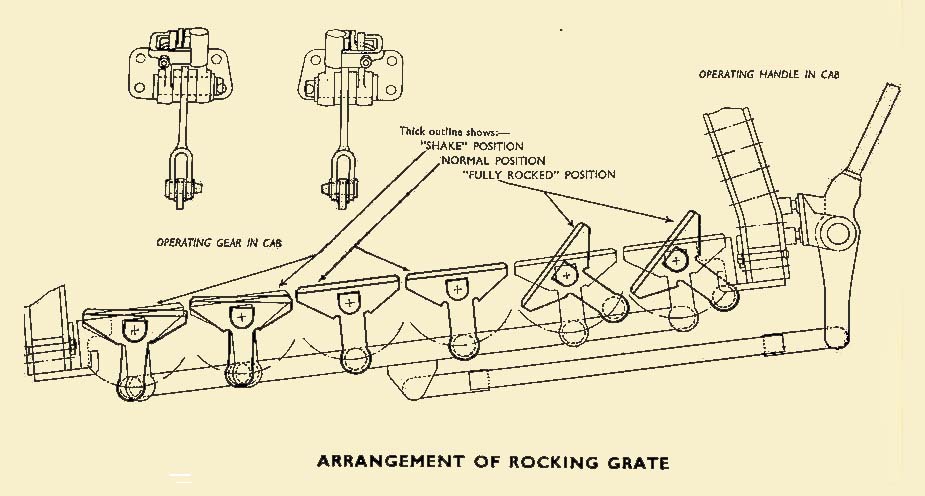
THE GREAT PAPER TRAIN CHASE
by Pat Kinsella
London's Waterloo Station was a hive of activity during the 1960s with tens of thousands of passengers in transit during the day but very few rail commuters saw it in the small hours when the
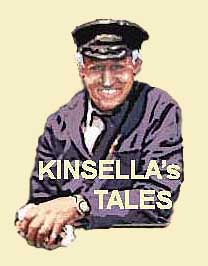 morning paper trains were being loaded with bundles of newspapers for shipment to towns between London and the south coast.
morning paper trains were being loaded with bundles of newspapers for shipment to towns between London and the south coast.To facilitate the loading of these trains, a thoroughfare connecting York Road up to concourse level between Platforms 11 and 12 was used for transferring bundles of newspapers hot off the presses in Fleet Street. Paper vans from the 'Daily Mirror', 'Herald', 'Telegraph', Times' and 'Guardian' would arrive at the station loaded with large bundles of perhaps two hundred copies or more, ready for sorting en route. A loading supervisor seated himself at a pedestal desk on Platform 11 to direct operations (see Cuneo's superb painting above). The supervisor would also issue free newspapers stamped with the word 'Gratis' in red ink on
 the front page for railway staff.
the front page for railway staff.However, this 'perk' was not enough for one or two staff, who proceeded to take their own supply. This was done by holding a paper bundle by the string and bouncing it up and down thereby loosening the string just enough to allow them to roll up two or three papers and slide them out from the top without damaging the bundle. This would then be repeated with other bundles to supply colleagues in different departments or stations.
A team of sorters travelled in a section of the train to sort the newspapers into smaller bundles for delivery to stations and newsagents en route. Some paper trains had a number of coaches for passengers but most were made up of large vans or PMVs. Members of railway staff travelling
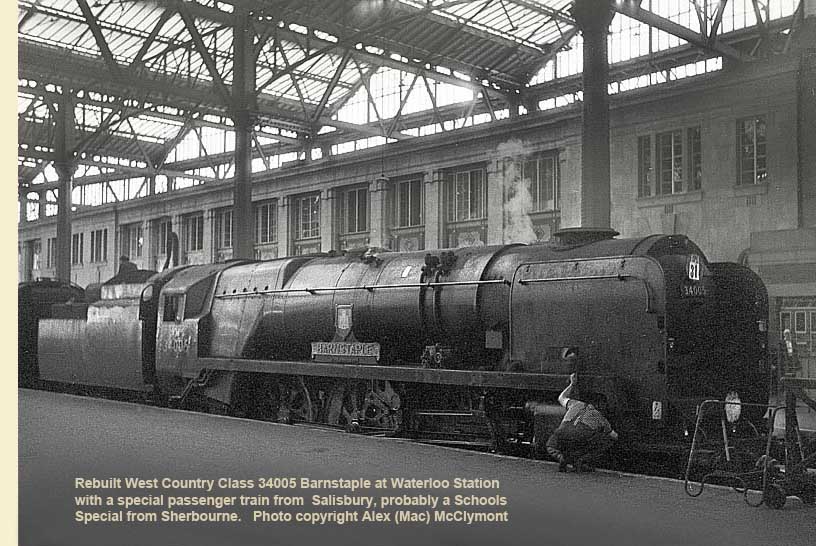 home after a night shift were permitted to travel in the spare guard's compartments, and this provided another opportunity to pilfer newspapers. The first major calling point out of Waterloo was Woking, where station staff would supply fresh tea served in milk bottles to the sorters in return for yet more papers. Sometimes the loco crews threw out newspapers to signalmen at such locations as Farncombe, Milford and Liss....crikey were there any papers left?
home after a night shift were permitted to travel in the spare guard's compartments, and this provided another opportunity to pilfer newspapers. The first major calling point out of Waterloo was Woking, where station staff would supply fresh tea served in milk bottles to the sorters in return for yet more papers. Sometimes the loco crews threw out newspapers to signalmen at such locations as Farncombe, Milford and Liss....crikey were there any papers left?To underline how many papers were falsely distributed I remember one morning standing on Platform 5 at Woking and hearing an incoming train sounding the whistle, and wondered why the driver had whistled up. In fact he was alerting the supervisor of his approach and discharged a complete bundle of papers onto the platform at his feet as the train passed through at a leisurely pace.
I recall an early turn at Guildford where a crew took an engine light to Woking ready to couple on to
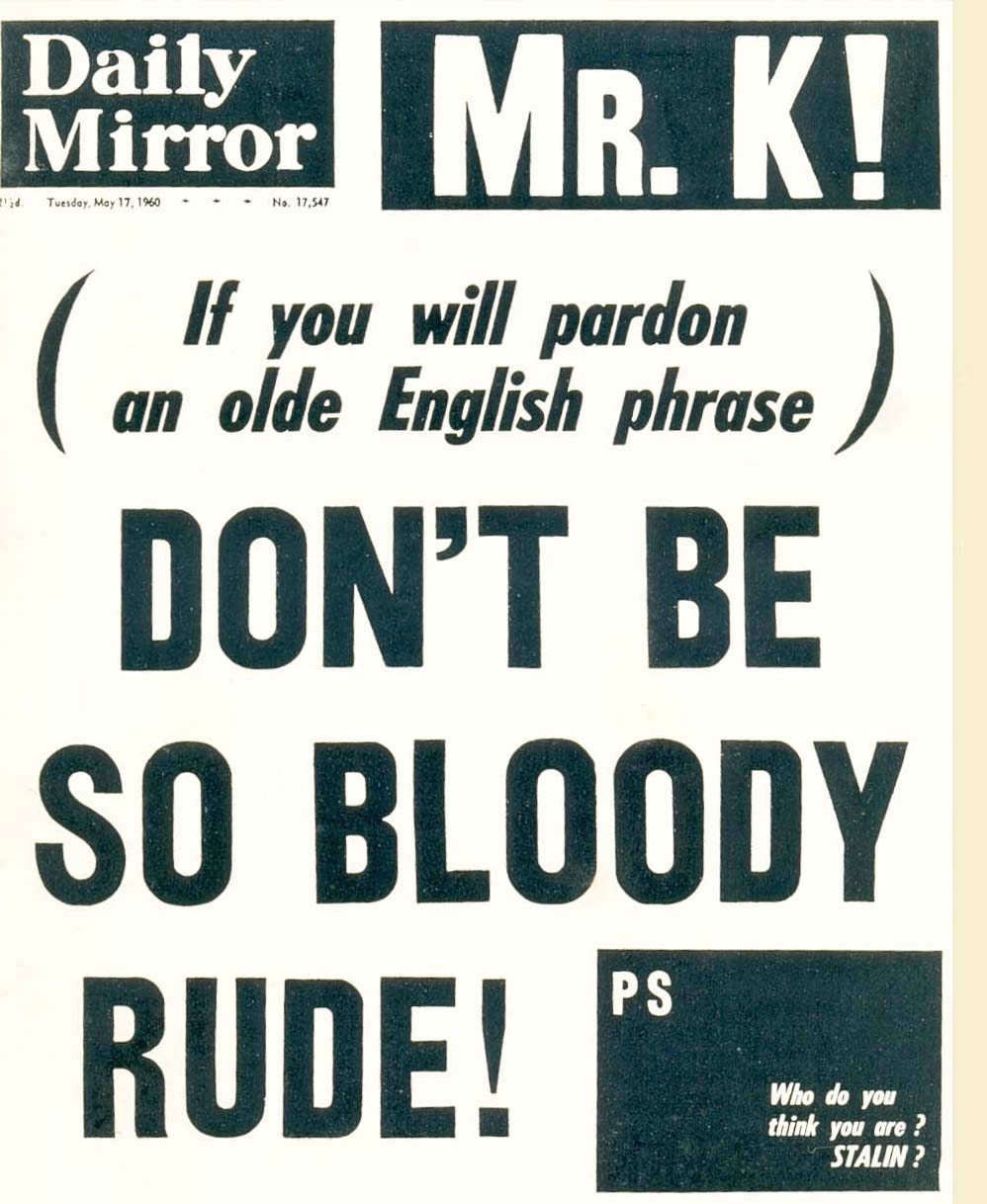 the rear portion of the 2.45 am papers from Waterloo, the rear of which was detached for hauling to Portsmouth Harbour via Petersfield departing about 3.20 am. On the 26th February 1964, I was booked to work this train with my regular driver Jackie Gaff, the same day that Cassius Clay (Muhammad Ali) was due to fight Sonny Liston in a World Heavyweight Champion title fight at the Convention Hall, Miami Beach, Florida. The 22 year-old challenger was known as the 'Louisville Lip' because of his talent for verbally taunting his opponents in the run-up to fights, and most commentators, including the respected 'Wilson' of the Daily Mirror, believed that the swaggering Clay (who boasted he could 'float like a butterfly and sting like a bee') was going to be slaughtered by the 'Big Ugly Bear' as Clay referred to him.
the rear portion of the 2.45 am papers from Waterloo, the rear of which was detached for hauling to Portsmouth Harbour via Petersfield departing about 3.20 am. On the 26th February 1964, I was booked to work this train with my regular driver Jackie Gaff, the same day that Cassius Clay (Muhammad Ali) was due to fight Sonny Liston in a World Heavyweight Champion title fight at the Convention Hall, Miami Beach, Florida. The 22 year-old challenger was known as the 'Louisville Lip' because of his talent for verbally taunting his opponents in the run-up to fights, and most commentators, including the respected 'Wilson' of the Daily Mirror, believed that the swaggering Clay (who boasted he could 'float like a butterfly and sting like a bee') was going to be slaughtered by the 'Big Ugly Bear' as Clay referred to him.Our locomotive, a BR Standard class Five, was steaming well (makes a change for you Kinsella, I hear you all chorus) which gave me a chance to listen to parts of the fight on my trusty 'Dansette' transistor radio. The fight was due to start at 3.10am GMT, and perhaps I was expecting a lot from my 'Dansette' since the footplate was all steel with the covered-in steel tender, and as we steamed up Haslemere bank I had to hang out of the cab holding on with one hand while clamping the radio to my ear with the other. Approaching 'Pigs 'Farm Lane Bridge' I heard the commentator shout - 'He's out, he's out!' The reception was very poor and I assumed that Clay had been beaten. I shouted to my driver that Liston was the winner. But then
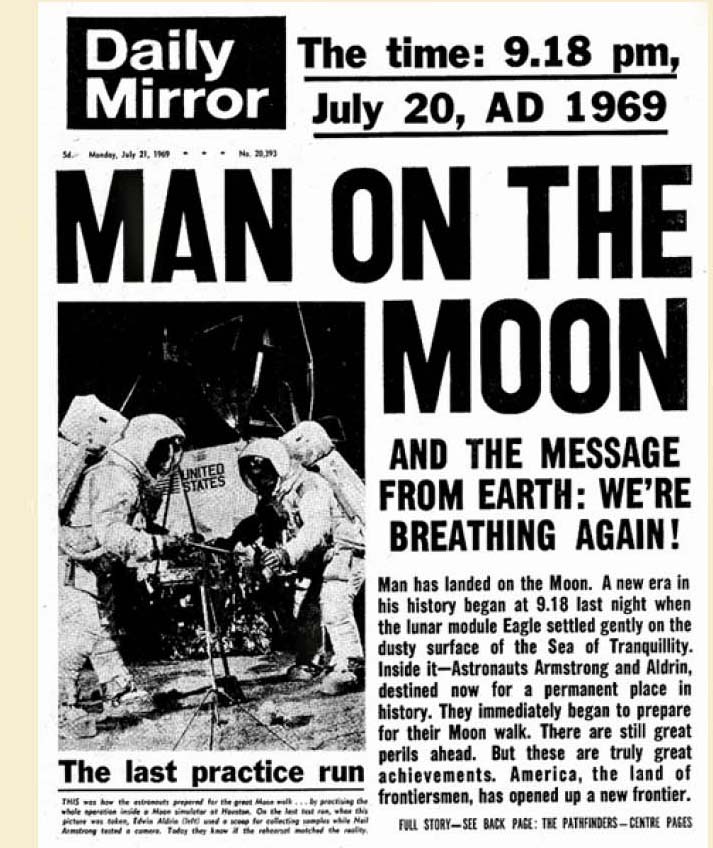 fifteen or so minutes later we came to a stand in Petersfield and I heard correctly - Clay, amazingly, had defeated Liston in the seventh round - the youngest boxer ever to take the title from a reigning heavyweight champion.
fifteen or so minutes later we came to a stand in Petersfield and I heard correctly - Clay, amazingly, had defeated Liston in the seventh round - the youngest boxer ever to take the title from a reigning heavyweight champion.Some of our 'young blades' on the footplate used to try and establish a timings record between Woking and Petersfield, however the trouble with this was that the paper sorters were unable to stand up to sort the papers thus delaying the departure from Petersfield until the sorting was complete.
Our dignified arrival at the Harbour was always a delight with the added bonus of having time to brew a can of tea whilst work continued apace unloading bundles of papers onto barrows hauled by 'Lister' tractors. There was always movement in Portsmouth Harbour with the coming and going of ferries to the Isle of Wight, Gosport and the continent as well as naval ships and tugs. Some of the tugs were 'paddlers', which could turn on their own axis by reversing the paddles against each other; their manoeuvrability and phenomenal strength enabled them to push and pull all vessels, including aircraft carriers.
When all work was finished we propelled our train back through Portsmouth High Level station to Fratton yard under the instructions of a shunter waving a green flag riding in the rear most van. Uncoupling our locomotive from the train we would then turn it via the rear of the carriage sidings and yard triangle before disposal at the loco shed and travelling home pass to Guildford.
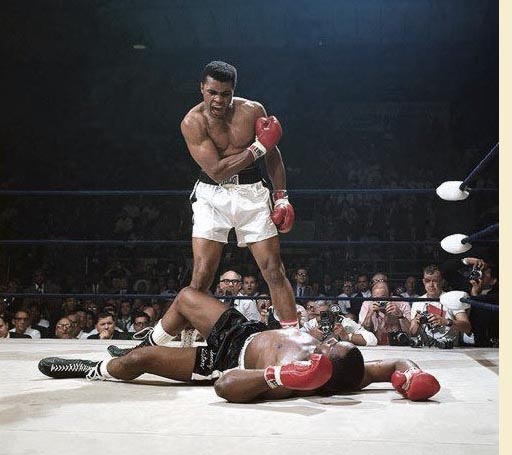 Travelling home on the 'cushions' in the rush hour was not an experience I relished. At times our overalls were quite dirty (depending on how many days they had been worn) and having worked up a bit of a sweat disposing the locomotive we were conscious that our body odour left a lot to be desired. But then, not to worry, by coincidence passengers entering our compartment on route only stayed for one station stop...
Travelling home on the 'cushions' in the rush hour was not an experience I relished. At times our overalls were quite dirty (depending on how many days they had been worn) and having worked up a bit of a sweat disposing the locomotive we were conscious that our body odour left a lot to be desired. But then, not to worry, by coincidence passengers entering our compartment on route only stayed for one station stop...(Left) During the first World Heavyweight Champion fight in Miami Beach in February 1964, Liston lost his title when he refused to come out of his corner for the seventh round, claiming that his left shoulder had been injured. However, more controversy overshadowed their second encounter in Lewiston Maine in May 1965, when Liston went down to a blow known as 'the phantom punch' - so named because most people at ringside did not see it. Although it appeared that Liston was able to get up, he chose not to, hence Cassius Clay (who by this time had changed his name to Muhammad Ali) was awarded a first-round KO. This decision remains one of the most controversial in boxing history; a moment captured by ringside photographer Neil Leifer showing Ali standing over his fallen opponent, gesturing and yelling - 'Get up and fight, sucker!' This superb ringside photo has become one of the most iconic sporting images in the history of the media; it was chosen for the cover of the Sports Illustrated special issue - 'The Century's Greatest Sports Photos'. Click here for link.
DAVE (SAM) SALMON's SOUTHERN REGION GALLERY
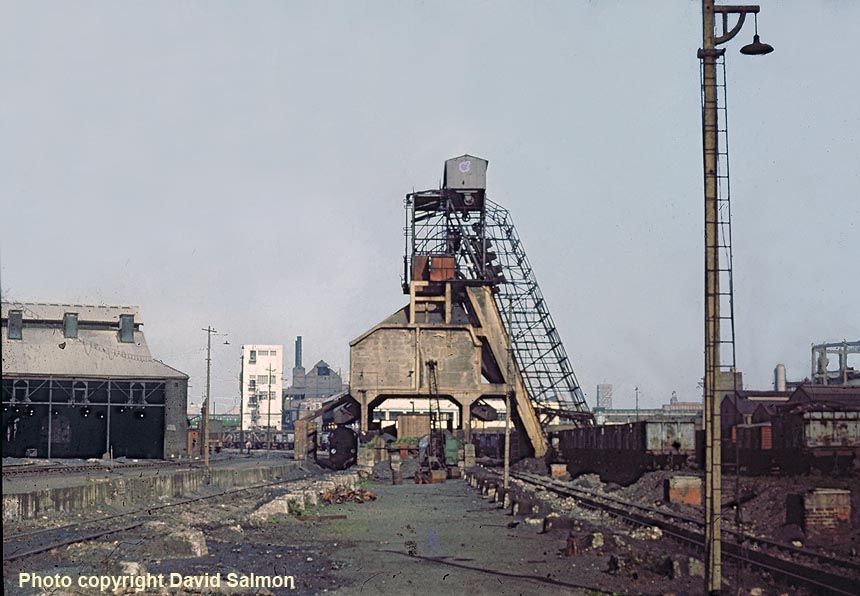
(Above) This photo of Nine Elms shed (70A) is just one of several shots that Dave Salmon took from the same spot; with a little judicious Photoshopping (matching up the photos side by side) it is hoped to cobble together the photos into a wonderful panoramic perspective of the entire shed yard at 70A. The whole area is now occupied by the New Covent Garden Market which is the largest wholesale fruit, vegetable and flower market in the UK - a far cry from BR steam days!
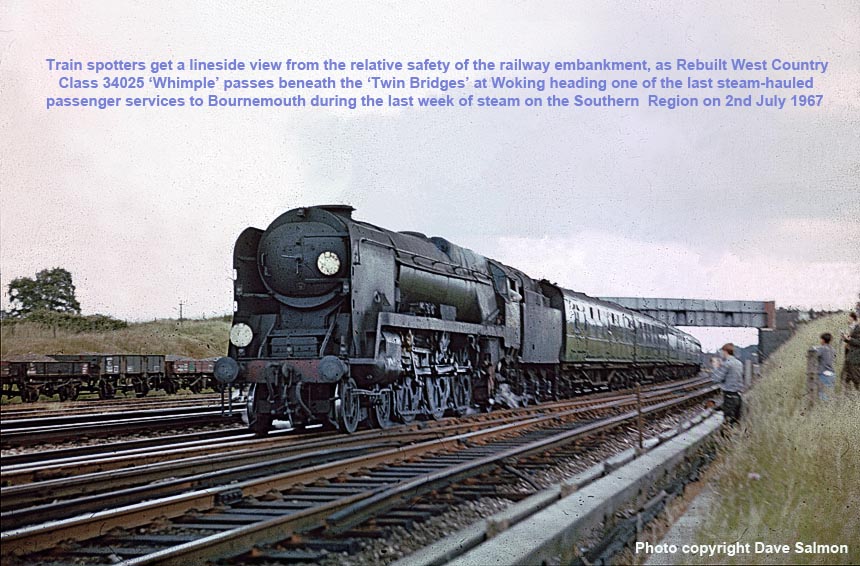

(Above-Below) Guildford Shed Steamraiser Claude Johns operates the injector on BR Standard Class 4MT 76033 at the coalstage. BR Standard Class 5MT 73086 'The Green Knight' stands in the background and awaits her next turn of duty on 26th June 1966. (Below) Taken on another day, this ground view shows a close up of the motion of BR Standard Class 5MT 73086 'The Green Knight' as she stands berthed in the Coal Road at Guildford Coal Stage. An unidentified Rebuilt WC/BB Class locomotive stands behind her minus her nameplates.

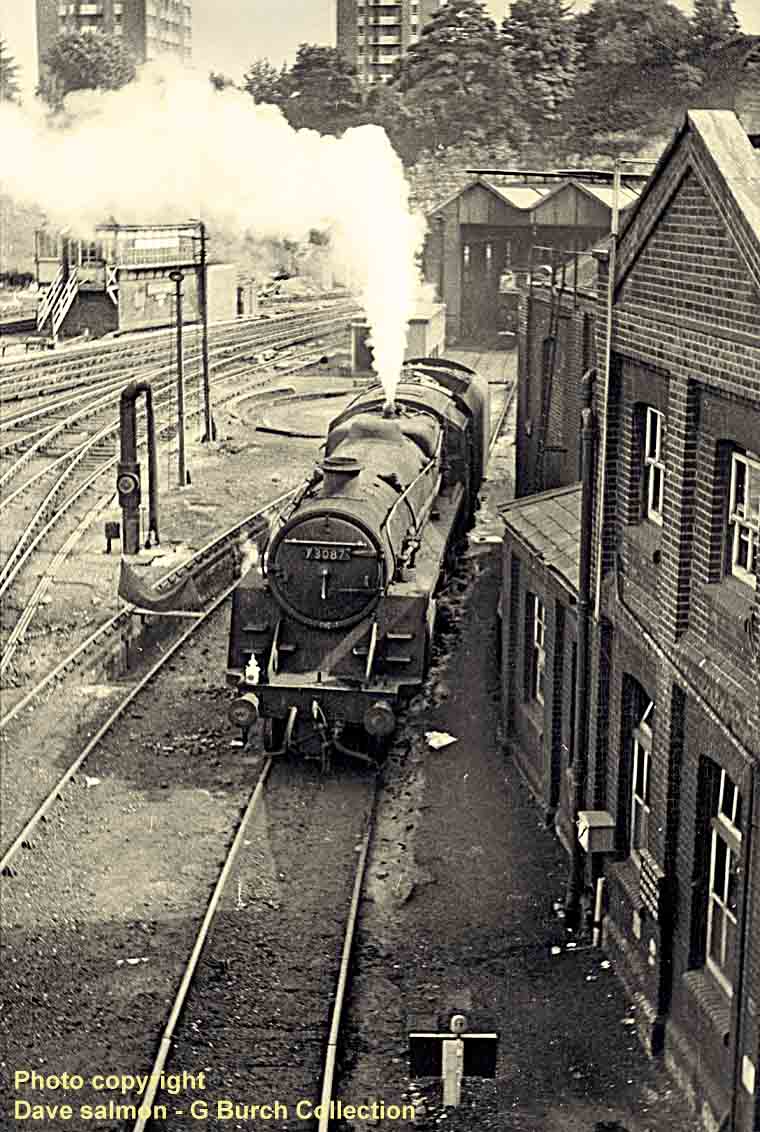
(Above-Below) BR Standard Class 5MT 73087 'Linette' moves from the Old Pit towards the turntable at Guildford Shed. With careful balancing, all the Class 5MT Standards could be turned on Guildford's turntable by using the vacuum apparatus or by hand. (Below) Guildford Driver Jack Cook has just berthed Battle of Britain Class 34051 'Winston Churchill' in the Back Road of the Coal Stage at Guildford to await further duties. A Salisbury based locomotive, she would most certainly have worked a loaded stone train from Salisbury to Woking Yard before running light engine to Guildford for disposal. In order to be engine first for her return trip to Salisbury (stone train empties), the locomotive would have run light engine via the Addlestone Junction and Weybridge triangle as it wasn't possible to turn a locomotive of this length on the turntable at Guildford. Sister locomotive Original Battle of Britain Class 34066 'Spitfire' (standing in the rear) would have made a similar journey.

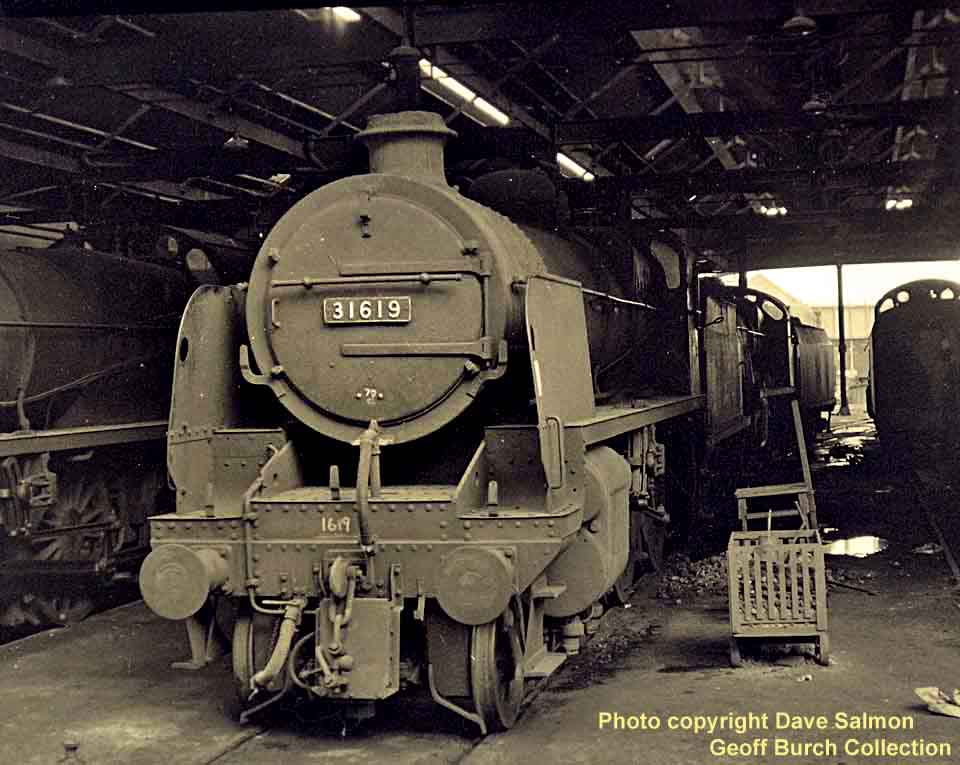
(Above-Below) Guildford-based U Class 31619 stands at the bottom of Guildford New Shed, its missing 70C shedplate replaced with chalk. The brazier (or fire devil) besides the loco would be used in the winter months to keep the loco's cold water pipes from tender to engine from freezing up. (Below) U Class 31809 and N Class 31842 both stand berthed at the bottom of Guildford New Shed awaiting their next turn of duty
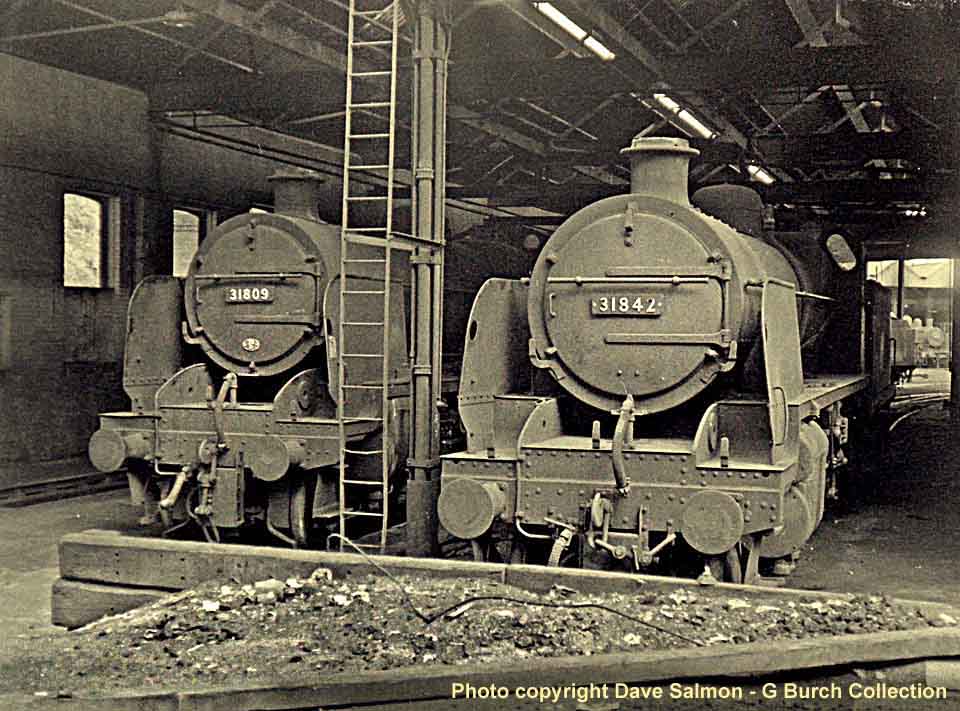
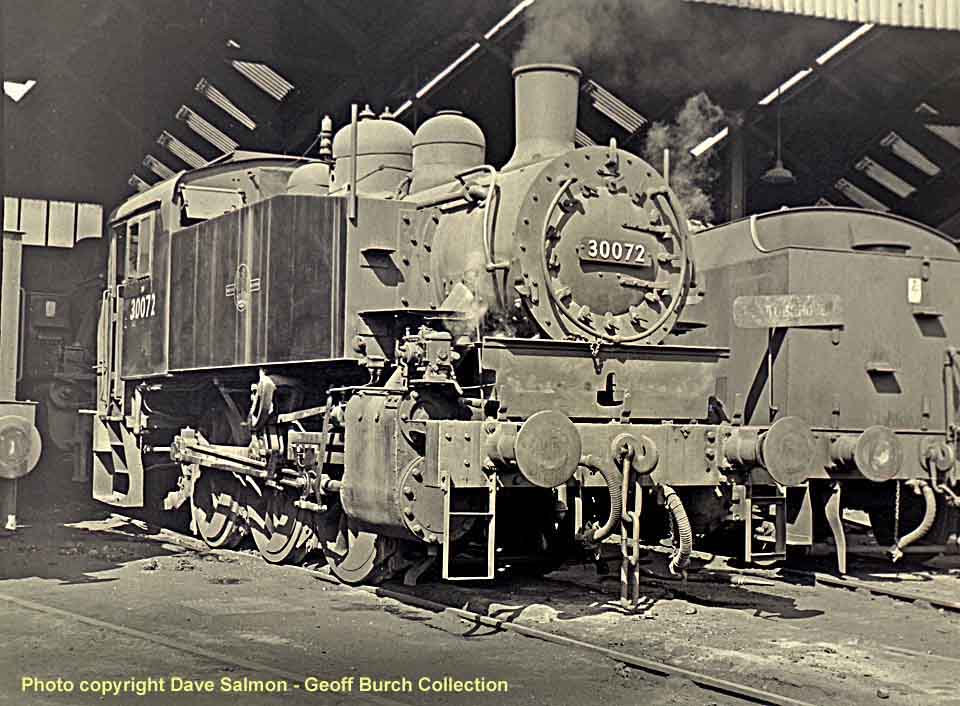
(Above-Below) USA Class 30072 stands in number 2 Road of the Old Shed (her usual position was in the Stores Road - ie number 1 Road). She was the last locomotive to leave the depot on the final day of steam 9th July 1967. (Below) USA Class 30069 shunts towards the depot exit at Eastleigh on 11th June 1966. Two of this class 30064 and 30072 were utilised as shed pilots in my time at Guildford. Four examples of this class have been preserved: 30064 on the Bluebell Railway, 30065 and 30070 on the Kent and East Sussex Railway, and 30072 on the Keighley & Worth Valley Railway.

(Below) BR Standard Class 5MT 73118 runs into Woking with an Up Bournemouth passenger service to Waterloo on 3rd June 1967. Already stripped earlier of her nameplate King Leodegrance she is now missing her smokebox number and shedplate. In the foreground a Plassermatic Lining Machine (used for re-aligning long welded rail) waits for signals on the Down Slow Line. 73118 was one of the last locomotives to leave Guildford MPD on the 9th July 1967 coupled with BR Standard Class 5MT 73155 bound for Salisbury and eventually the scrapyard at Barry.
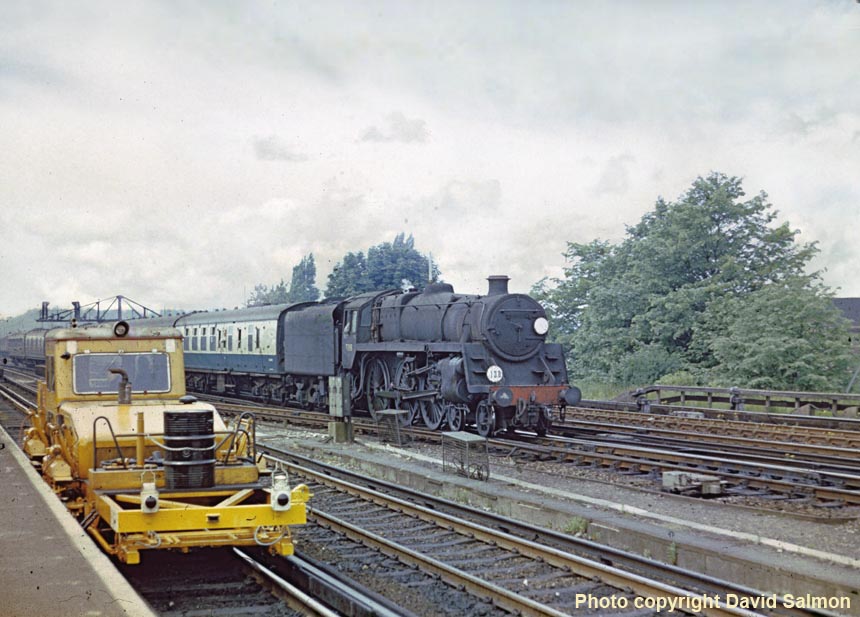
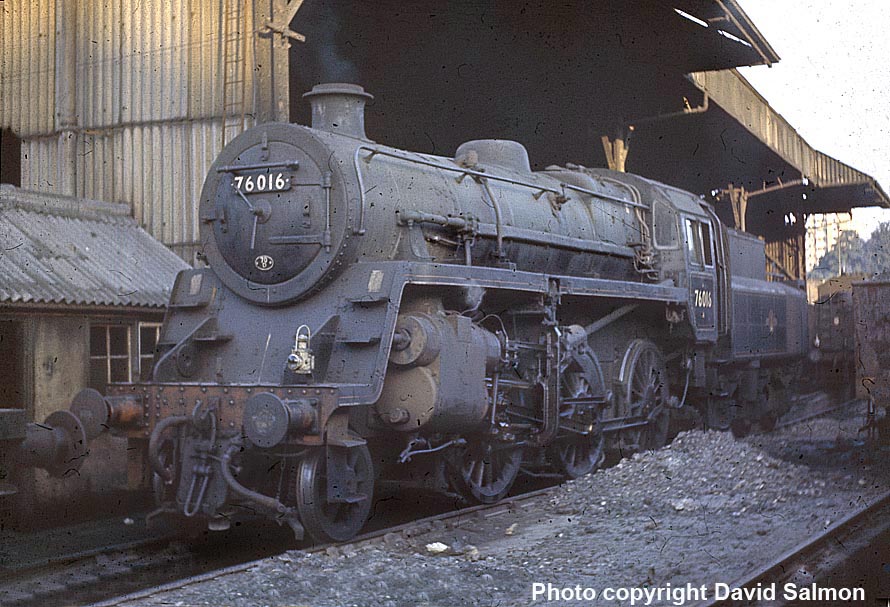
(Above-Below) Basingstoke's (70D) BR Standard Class 4MT 76016 rests outside of the Coalman's hut at Guildford MPD. The 'SC' plate (self cleaning smokebox) is still attached along with the smokebox number plate but for how long? With the demise of steam gathering pace such items as number plates and especially nameplates became very much collectors' items and unauthorised removal (theft) increased at a steady rate. Designed at Doncaster and introduced in 1953, 115 of these locomotives were built and served a number of Southern Region depots. (Below) The fireman looks back for the tip from the Guard as Rebuilt West Country Class 34095 'Brentor' waits to leave with a semi-fast passenger service from Woking to Waterloo on 11th June 1966. The resident 204hp Drewry diesel East End shunting loco can be seen running into Woking on the Down Local line. 34095 had the honour of hauling one of the last steam passenger services - the 18:15 Weymouth-Waterloo on 7th July 1967.

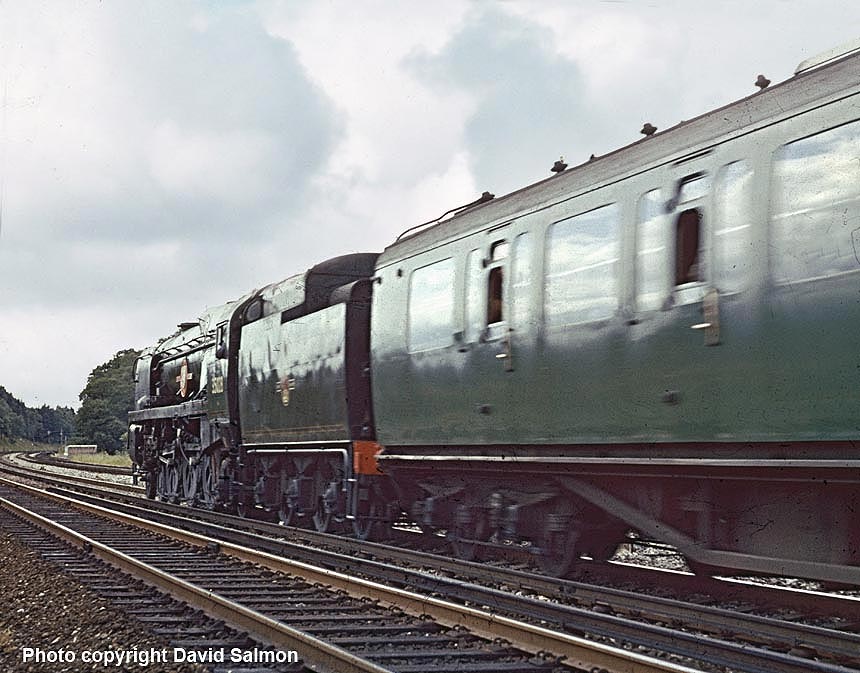
(Above-Below) Rebuilt Merchant Navy Class 35028 'Clan Line' passes under Twin Bridges, Woking and heads off to Bournemouth and return with a farewell special charter on 2nd July 1967. After she was rebuilt in 1959 she was initially allocated to Nine Elms shed where she headed such trains as the 'Bournemouth Belle' and the 'Atlantic Coast Express'. Indeed it was while working the A.C.E. in 1961 that she was unofficially timed at 104 mph passing Axminster. 35028 is currently owned by the Merchant Navy Preservation Society - link to the Society's website here. (Below) Rebuilt Merchant Navy Class 35013 'Blue Funnel' accelerates through Woking with a Bournemouth express after being signal checked on 11th June 1966. A Post Office worker is hauling a trolley of mailbags on platform five - a mail train in the Dock road is also being emptied; there are parcels and mailbags strewn everywhere.
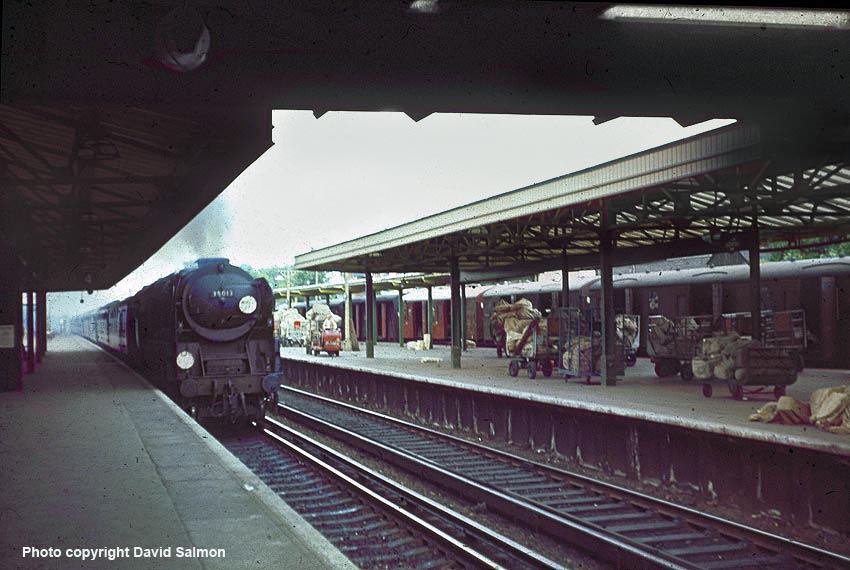

(Above-Below) With 'feather' flying, Rebuilt Merchant Navy Class 35019 'French line CGT' rushes through Woking with a Bournemouth express on 25th May 1965. Sadly, she was withdrawn the same year. On the right of the photograph above the coaches in the sidings is the water tower that fed the boilers and heating system of the Woking 'Control' offices below which was the 'nerve centre' of the South Western Division. (Below) BR Standard Class 4MT 76053 stands over the pit waiting for coal at Guildford MPD. The disc boards affixed to the smokebox denote that she's run light engine to Guildford, probably from Woking.
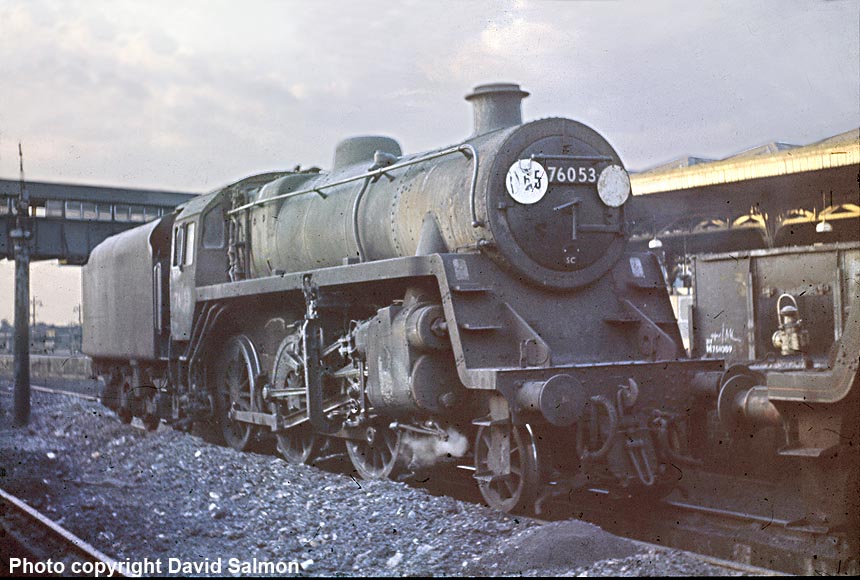
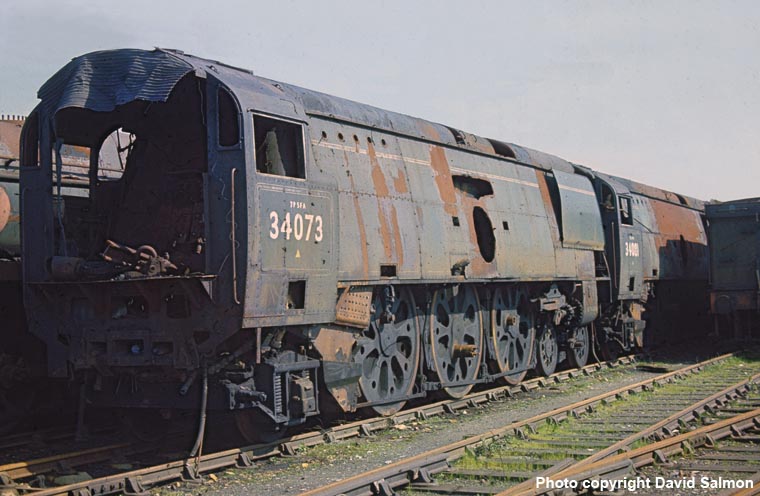
(Above-Below) Unrebuilt Battle of Britain Class 34073 '249 Squadron' and 34081 '92 Squadron' wait in line at Woodhams scrapyard at Barry. Thankfully, both locomotives didn't meet their end - 34073 is still unrestored and 34081 is receiving an overhaul at the Nene Valley Railway. (Below) Ex-Guildford (70C) Q1 Class 33020 rusts away amongst the weeds waiting for the inevitable on 13th August 1966. The Q1s thrived on their intended duties in World War II, during which time the class proved an indispensable addition to the Southern locomotive fleet; unsurprisingly these sturdy austerity locos all remained in service until the 1960s, long after they were intended for withdrawal. Inroads began in 1963 during the implementation of the BR Modernisation Plan, which saw the end of steam operations on Britain's railways, the last example of the class being withdrawn in 1966. Only one of the class was saved and is currently an exhibit at the National Rail Museum at York.
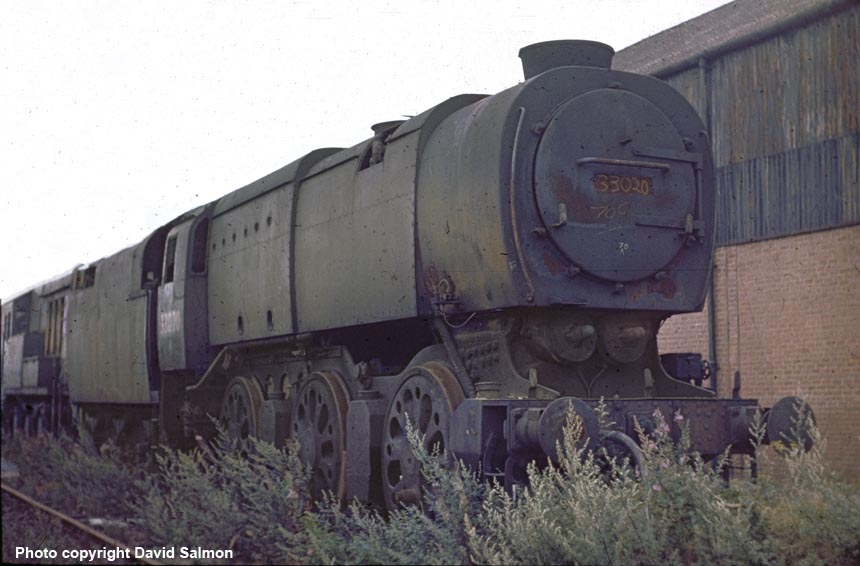
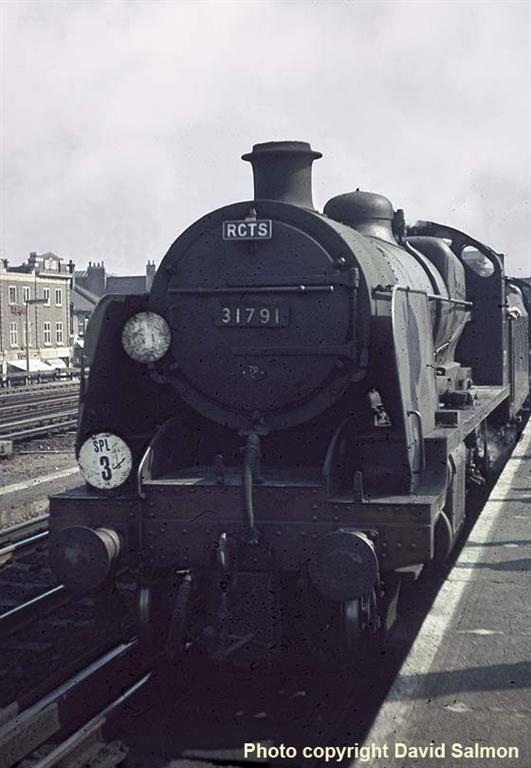
(Above-Below) U Class 31791 and 31639 have arrived at Woking on the first leg of the RCTS Longmoor Rail Tour on Saturday 30th April 1966. The tour started at Waterloo and ran to Woking where the pair of Maunsell locos were changed for WD Class 600 'Gordon' which then worked the second leg via Guildford, Haslemere and Liss to the Longmoor Military Railway. (Below) WD Class 600 'Gordon' waits in the Down Bay (platform 6) at Woking prior to taking over the the RCTS Longmoor Rail Tour'. Guildford Driver, Denis Tack, conducted the train to Liss where a variety of WD locomotives were employed on the MOD's lines. WD Class 600 'Gordon' then continued the tour via Bordon, Bentley, Farnham, Ash Vale, Frimley, Ascot and Staines where BR Standard Class 5MT 73114 'Etarre' worked the train to Windsor and Eton Riverside. The final leg of the journey to Waterloo was performed by the original U Class locos Nos 31791 and 31639.
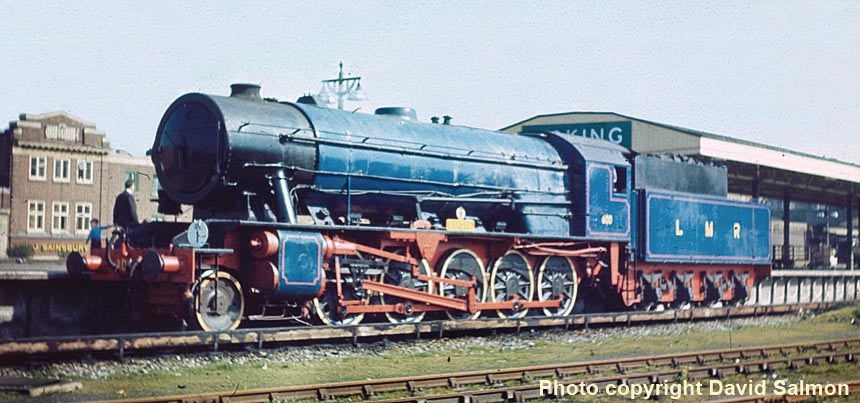
(Below) I am pleased to include a page from the catalogue that accompanied the Railway Correspondence and Travellers Society's 'Longmoor Rail Tour' on Saturday 30th April 1966 since it features a map of the route plus details of the origin of the Longmoor nameplate carried by the thousandth British-built locomotive (North British 2-10-0) shipped to the continent after 'D' Day. Click on image to enlarge...

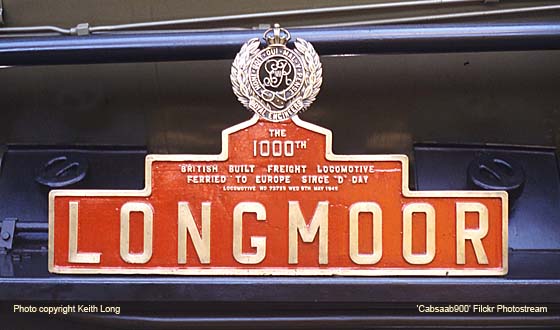
ONE OF THOSE DAYS by Pat Kinsella
Wednesday 26th December 1963, Boxing Day...a cold snap over the Christmas festivities culminated in a snowstorm over the Southern Counties of England starting at 9.00pm in the evening. Very
 unusually, in our part of the country, heavy snow continued to fall until about 9.00am the following morning. It laid to more than twelve inches on open ground but built up to six or seven feet in drifts in some areas with the wind behind it. This was especially so on higher ground such as Haslemere. Temperatures then fell alarmingly and stayed freezing for several weeks.
unusually, in our part of the country, heavy snow continued to fall until about 9.00am the following morning. It laid to more than twelve inches on open ground but built up to six or seven feet in drifts in some areas with the wind behind it. This was especially so on higher ground such as Haslemere. Temperatures then fell alarmingly and stayed freezing for several weeks.Enormous stalactite type icicles developed under bridges and inside tunnels, a few, as under Church Lane East Bridge at Aldershot, grew to a length of eight feet and about a foot wide at the top. These obstacles were very hazardous, English locomotives did not carry headlights so engine crews were left 'in the dark' so to speak and were best advised to keep their heads inside the cab
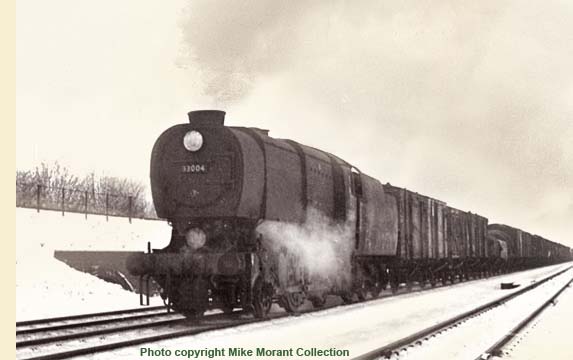 when passing under bridges during the hours of darkness and when passing through tunnels (some tunnels continually dripped water all year round).
when passing under bridges during the hours of darkness and when passing through tunnels (some tunnels continually dripped water all year round).Following the initial snowfall, days and nights were occupied by trackmen clearing snow from points, rods, signal cables and pulleys. Calor gas point heaters were installed at some key locations at that time but the bottles were not always replenished or the burners remained unlit, resulting in frozen points.
Consequently, there was massive delay and cancellations to trains during this difficult time. The railway in the Haslemere area was covered by deep frozen snow, especially in places where no linemen had trodden since the blizzard began. This remained the situation a couple of weeks or so into January when I rotated to a week of early turn duties...
My day started at 3am with a three mile walk to work for an early turn on a freezing cold January morning with twelve inches of snow on the ground. For the whole month of January 1963 there was no let up with the 'big freeze'. Our duty that day was to work the Guildford to Petersfield fright, which was running about 90 minutes late due to the weather conditions.
 My Driver was Ted Fry, a quirky character, who addressed everyone as 'Old Boy'; indeed his eccentricity led to him being described as a gentleman of the old school…well, I'm not sure about that but I do remember him being a cool customer under pressure. Our locomotive was a Q1 Class, 33022 and the train a full load, equal to60 wagons.
My Driver was Ted Fry, a quirky character, who addressed everyone as 'Old Boy'; indeed his eccentricity led to him being described as a gentleman of the old school…well, I'm not sure about that but I do remember him being a cool customer under pressure. Our locomotive was a Q1 Class, 33022 and the train a full load, equal to60 wagons.Departing Guildford yard, we struggled along, down for steam - no change there then some of my colleagues would say - but enough to take us up the 1 in 80 rising gradient to Haslemere summit; 515 feetabove sea level. As was the procedure at the time, we were signalled into platform 2 (up main) to enable us to uncouple the Haslemere wagons and run round via the down line and then 'run the wagons off' into the down sidings London end of the station.
As we had a full load, Ted pulled down hard on the Down Starter signal to clear the Guards van of the up loop at the London-end of the station. Meanwhile I busied myself with getting steam back; the fire looked like a huge blob of cooling molten lava, and the small briquettes masquerading as coal
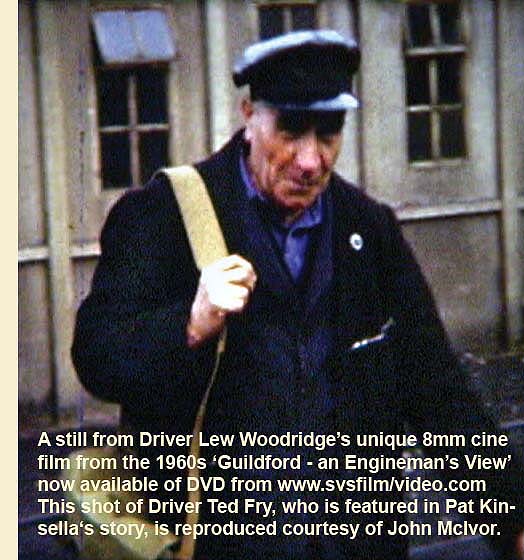 did not help. (The fire should have been cleaned before the locomotive entered service.) After uncoupling the Haslemere portion of the train, the Shunter said 'Right' to my Driver who thought it to mean that we had the signal to move forward, and as the signal was situated on the fireman's side of the locomotive Ted was unaware that we were passing the signal at danger. (I was equally to blame as I should have been looking out).
did not help. (The fire should have been cleaned before the locomotive entered service.) After uncoupling the Haslemere portion of the train, the Shunter said 'Right' to my Driver who thought it to mean that we had the signal to move forward, and as the signal was situated on the fireman's side of the locomotive Ted was unaware that we were passing the signal at danger. (I was equally to blame as I should have been looking out).He only realized the error when we didn't cross over to the Down line. To make matters worse, the detonator machine positioned beyond the Starting signal (to prevent such an error occurring) hadn't been loaded.
Stopping immediately, Ted instructed the shunter, who had joined us on the footplate, to go back and make sure we were clear of the up loop points as he intended to set back onto our train because an up passenger train was due. On returning to the points the shunter stumbled awkwardly in the deep snow, raising his arm upwards as he did so. Looking out from the cab, Ted took his flailing arms as a hand signal - the tip to move - and began reversing back towards the rear of our train.
Unfortunately the rear coal wagon wasn't clear of the points and as we had only just 'run through' the points (which were set for the up loop) we derailed four wagons and cut through the 650 volt supply cable for the electric rail in the process. I saw a tremendous flash and for one terrible moment I thought the shunter - who was standing so very close - had been electrocuted, but he was lucky!
33022 was unaffected by the derailment, but both up and down lines together with the up loop line were now completely blocked. Ted instructed me to proceed to the 'Up Home' signal to put down detonator protection. On arrival I was confronted with a twelve car London bound commuter train at a standstill having suffered a loss of power and the signal being automatically reversed to red. The
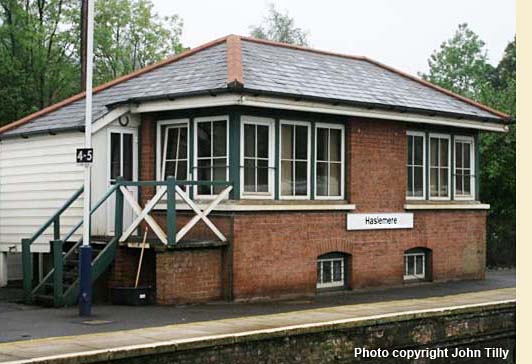 driver was endeavouring to contact the signalman on the signalpost telephone but it was out of order.
driver was endeavouring to contact the signalman on the signalpost telephone but it was out of order.Returning to the loco, the inimitable Ted - cool as you like - decided that while we waited for instructions we should have a 'nice can of tea, old boy'. I struggled to the signal box and returned trudging through a foot of snow with our 'nice can of tea' which was very welcome.
Shortly after, when the Platform Foreman paid us a visit I enquired what was being done about the twelve-car train standing at the Home Signal?
'There's no train on the home signal!' he shot back.
'There is!' I insisted.
'No, that's the roof of the brake van in the up siding you're looking at.'
'No it isn't!'
'Oh yes it is!' he countered.
'It's not, there's a train on the home signal…I've been down there to protect.'
As the realization dawned that this twit of a fireman, who was probably the cause of this debacle in the first place, may just be right all along, a pained expression slowly spread across his face - 'Sod it!' was his departing exclamation.
An hour later, Ted was issued with the Liphook signalman's yellow wrong line order form 'D' permitting us to take our locomotive down onto the commuter train for the purpose of assisting it back wrong road to Liphook. Meanwhile the catch points by the A287 road bridge had been plugged and clipped as per instructions for 'wrong line' orders. However, since our locomotive was vacuum brake-fitted only, the plan was to propel the stranded train back to Liphook while using 'hand brakes' for stopping as the twelve-coach train consisting of 'Bils' and 'Hals' (non corridor connection between units) which were by now devoid of air after standing for so long with no compressors or heating for the passengers (they were made of sterner stuff in those days)!
As we neared the 'failure' I was descending the loco steps in preparation to couple up and saw the Fratton driver, together with his guard, waiting on the ground when something extraordinary happened - their train started to move on its own! Later at the enquiry there was some speculation as to whether or not we went straight onto the train without 'stopping short' first as per the rule book, but I personally believe that it began to move before we reached it; that the vibration of our loco was enough to start the movement on the falling gradient even though the leading coach handbrake had definitely been applied.
Gaining momentum on the 1 in 100 falling gradient towards Portsmouth, the crew and onlookers on the ground were unable to reach the train's second coach's handbrake (non-corridor stock
 remember) and the snow was up to our shins! As the runaway gathered speed quickly, a noble effort was made by the localStation Master, who, having reached the leading London-end cab, found the handbrake already applied (see insert left). He jumped down into the snow and ran alongside the runaway train towards the second cab, but the acceleration was such that our gallant hero failed to reach it and he fell to his knees utterly exhausted. Ted stopped our locomotive to pick him up and I offered him my seat; he climbed into the cab gasping for air and removed his Station Master's hat (you remember the one, like a large black dinner plate with a handle) to wipe his brow. But as he slumped into my seat he gave his head a right crack on the hydrostatic lubricator - 'Who put that bloody thing in such a bloody stupid place!' he complained.
remember) and the snow was up to our shins! As the runaway gathered speed quickly, a noble effort was made by the localStation Master, who, having reached the leading London-end cab, found the handbrake already applied (see insert left). He jumped down into the snow and ran alongside the runaway train towards the second cab, but the acceleration was such that our gallant hero failed to reach it and he fell to his knees utterly exhausted. Ted stopped our locomotive to pick him up and I offered him my seat; he climbed into the cab gasping for air and removed his Station Master's hat (you remember the one, like a large black dinner plate with a handle) to wipe his brow. But as he slumped into my seat he gave his head a right crack on the hydrostatic lubricator - 'Who put that bloody thing in such a bloody stupid place!' he complained.'Oliver Bulleid.' I replied thinking he would be impressed with my knowledge.
'Imbecile!' he bellowed.
I didn't know if he meant Bulleid or me but thought it imprudent to ask.
A little further down the track, I spotted the train Guard lying pole-axed on the bank wearing the snow like a shroud, his pipe emitting smoke like an advert for Sweet Erinmore tobacco.
'Stop, Stop!' I cried to Ted - 'There's the Guard lying in the snow freezing to death!'
'Leave him!' ordered the Senior Manager - 'We've got to catch that f***ing runaway!'
By now the train was out of sight and had passed Hammer Crossing.
As we approached Hammer Crossing in pursuit an observant trackman emerged from the crossing house shouting and waving red flags in all directions, 'Stop, Stop, Stop!' he bellowed in high tenor - 'A train has just gone down there!'
'We know that!' shouted the Senior Manager showing signs of recovering his dignity a little. Well, that is until Ted enquired of him if he should book this movement to freight or passenger shunting?
Following the runaway down the bank we eventually caught up after it came to a stand in the dip prior to Liphook just by the up advance starter semaphore signal, two and three quarter miles down the line!
It was a lucky day for the railway because I do believe that had the commuters realized they were on a runaway they would have very likely tried to 'bail out'.
After a bit of a 'confab' we coupled up and very cautiously propelled the 'runaway' back to a live section of electric rail in Liphook station where most of the passengers detrained and went home, probably due to the fact it was close on lunchtime.
Ted, after the inquiry, informed me that he heard no more about the incident, a fact I found difficult to believe. But then I suppose so many rules had been broken or ignored that it would have been difficult to word the charge sheet!
(Below) Class 7MT 70000 'Britannia' attacks Foxhills Bank, Pirbright on the 8th May 1994. The driver is none other than Pat Kinsella, and this is the first time that a steam locomotive had visited Southern metals with a passenger train since July 1967.


(Above-Below) During the late 1950s and early 1960s British Railways was a wonderful repository of pre-Grouping (pre-1923) steam locomotives, many introduced during the late 1800s. The Southern Region was no exception. Designed by RJ Billington for the LBSCR In 1897, the E4 class 0-6-2Ts were powerful engines for their size. They were designated Class 2P-2F and became stalwarts of local passenger, freight and branch line services for more than fifty years. Seventy-five members of the class were built at Brighton Works between December 1897 and September 1903, and all the class survived into Southern Railway ownership. One example was however destroyed as a result of enemy action at Eastbourne motive power depot in 1942. The remainder continued in regular use following nationalisation in 1948, but with the arrival of Diesel Multiple Units and a reduction in the number of branch lines due to the Beeching Axe, the locomotives gradually became surplus to operational requirements, and withdrawals commenced in 1955. The majority of the class was withdrawn between 1958 and 1964, but one of these locomotives (32473) remains in preservation on the Bluebell Railway. Here E4 Class 32506 is pictured on the turntable at Guildford 70C circa 1950. (Below) Another splendid photo from the Austin Attewell Collection, this one showing detail of the turntable at Guildford looking into the New Shed. Quite a number of locomotives remain unidentified but Shed Pilot B4 Class 30086 is at the right of the photograph.
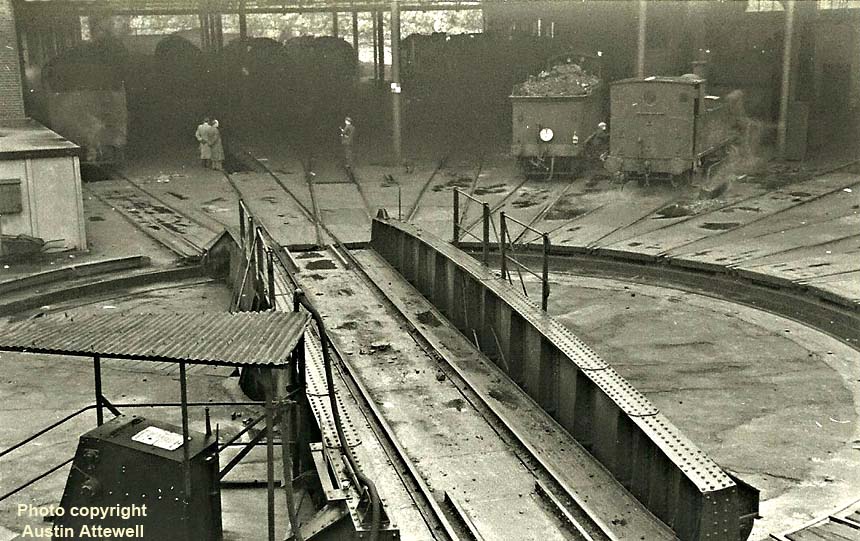

(Above-Inset Right-Below) A closer view of B4 Class 30086 with some very well dressed enthusiasts studying an Ian Allan ABC I expect! Introduced by Adams in 1891 the B4's were initially required to handle the expansion of traffic in the many small yards of the LSWR, particularly around the Plymouth area. Prior to the use of the B4 class, some of these yards had been using horses for their shunting needs, a situation which could not be sustained. The first order was for twenty engines to be built at Nine Elms Works, in two lots of ten, and was completed by December 1892. The twenty locomotives were spread fairly evenly around the system, and although they had a cramped and dirty footplate, with limited coal supplies, the little locos were powerful and became popular with
 their crews. In 1892, the LSWR gained control of the Southampton Docks and within a year, three of the B4 tanks were transferred to the docks. By 1900 a further 10 had been transferred, all painted in a dark green livery and given names generally associated with the ports on the Continent with which the LSWR had connections. 30086 was originally named 'Havre' and remained at Guildford until 1959 when she was withdrawn and replaced by sister B4 Class 30089. (Above Right) Another old timer, O4 Class 0-4-2 No.613, awaits a washout in the Old Shed at Guildford in 1936. Built by Neilson & Co in 1896 she survived until the year I was born - 1946. In the foreground are barrels of Superheated Steam Lubricating oil waiting to be shipped into the stores department. (Below) The elegant and curvaceous T9s must rank as being the best looking SR locos of all time! The longevity of Dugal Drummond's classic 'Greyhound' class 4-4-0 (introduced for the LSWR in 1899) was a result of RW Urie's brutal rebuilding and the last two members survived into June 1961, including 30120 which was selected by Eastleigh for preservation in full LSWR livery. Here Nos 30301 and 30732 (the latter with the original narrow cab and splasher arrangement, hence the need for a separate splasher over the coupling rod) are seen working the RCTS's 'Hampshireman' Railtour on Sunday 6th February 1955. This was the last train to run the complete length of the Meon Valley Railway which closed to passenger traffic the following day and to freight traffic over the central section of the line. This leg of the railtour was crewed by Guildford men - Driver Frank Tickner and Fireman Roy Vigars along with Driver Tommy Harding and Fireman Gordon Ballard.
their crews. In 1892, the LSWR gained control of the Southampton Docks and within a year, three of the B4 tanks were transferred to the docks. By 1900 a further 10 had been transferred, all painted in a dark green livery and given names generally associated with the ports on the Continent with which the LSWR had connections. 30086 was originally named 'Havre' and remained at Guildford until 1959 when she was withdrawn and replaced by sister B4 Class 30089. (Above Right) Another old timer, O4 Class 0-4-2 No.613, awaits a washout in the Old Shed at Guildford in 1936. Built by Neilson & Co in 1896 she survived until the year I was born - 1946. In the foreground are barrels of Superheated Steam Lubricating oil waiting to be shipped into the stores department. (Below) The elegant and curvaceous T9s must rank as being the best looking SR locos of all time! The longevity of Dugal Drummond's classic 'Greyhound' class 4-4-0 (introduced for the LSWR in 1899) was a result of RW Urie's brutal rebuilding and the last two members survived into June 1961, including 30120 which was selected by Eastleigh for preservation in full LSWR livery. Here Nos 30301 and 30732 (the latter with the original narrow cab and splasher arrangement, hence the need for a separate splasher over the coupling rod) are seen working the RCTS's 'Hampshireman' Railtour on Sunday 6th February 1955. This was the last train to run the complete length of the Meon Valley Railway which closed to passenger traffic the following day and to freight traffic over the central section of the line. This leg of the railtour was crewed by Guildford men - Driver Frank Tickner and Fireman Roy Vigars along with Driver Tommy Harding and Fireman Gordon Ballard.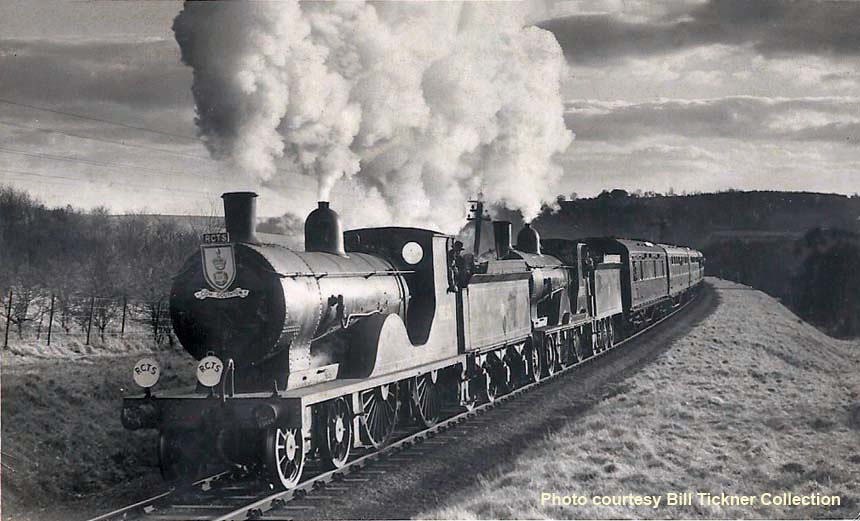
ALEX (MAC) McCLYMONT's COLLECTION
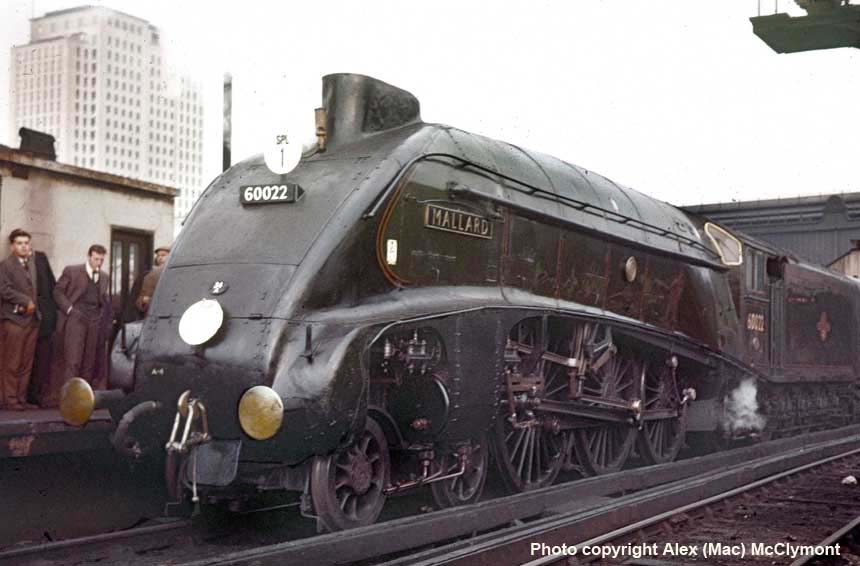
(Above-Below) Staying with the theme of railtours, on 24th February 1963 the Locomotive Club of Great Britain (LCGB) organised the 'West Countryman Limited' Railtour commemorate the 15th anniversary of the 1948 Locomotive Exchanges. Fittingly the LCGB acquired the services of Class A4 No 60022 Mallard which hauled the first leg from London Waterloo - Clapham Junction - East Putney - Wimbledon - Surbiton - Woking - Basingstoke - Andover Junction - Salisbury - Gillingham - Yeovil Junction - Axminster to Exeter Central, where apair of 2-6-2Ts Nos 4591 and 5564 were waiting to take the train via Exeter St Davids, Thorverton and Tiverton to Tiverton Junction. The return trip over the Hemyock branch was handled by 0-4-2T No 1450 before the Class A4 hauled the return leg via Taunton - Frome - Westbury - Newbury - Southcote Junction - Reading - Southall back to London Paddington. Mac photographed Mallard prior to the 9.05am departure from platform 11 at Waterloo and again after arrival at Exeter Central...no namby-pamby Health & Safety rules in those days!
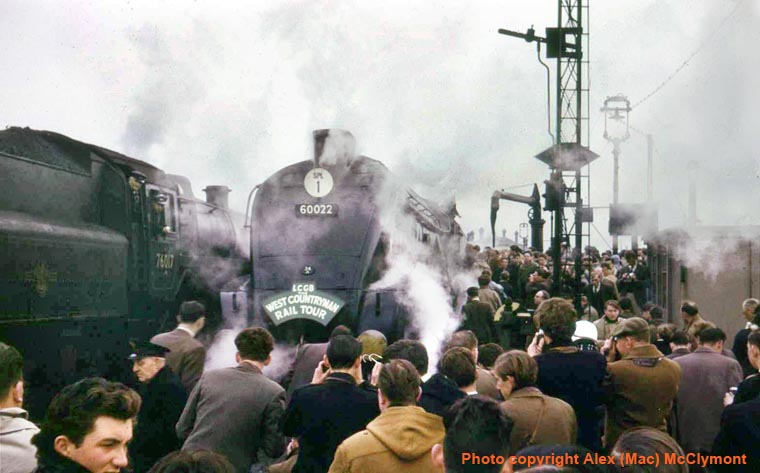

(Above-Below) Another foreign interloper on SR metals! On 25th August 1963, the Southern Counties Touring Society organised the 'Southern Counties Enterprise' hauled by Grantham Shed's (34F) Class A3 60112 St Simon from London Waterloo - Clapham Junction - Earlsfield - Wimbledon - Surbiton - Woking - Basingstoke - Winchester City - Eastleigh - Southampton Central - Brockenhurst - Bournemouth Central - Poole to Hamworthy Junction, where Class M7 30052 continued to Hamworthy and return. The A3 then hauled the special from Hamworthy Junction via Wareham and Dorchester South to Weymouth Junction where 0-6-0PTs Nos 7782 and 4689 did various out and back trips taking in Melcombe Regis - Portland - Easton - Dorchester West - Maiden Newton - Bridport - West Bay and back to Maiden Newton. 60112 continued the journey via Yeovil Pen Mill - Westbury - Westbury - Warminster - Salisbury - Andover Junction to Basingstoke, before taking the reverse of outward route back to London Waterloo. In Mac's first shot a cloudburst welcomes the visit of 60112 St Simon at Hamworthy. (Below) Here the Class M7 30052 (note the West Bay board at cantrail height on the coach) pauses whilst working the Hamworthy Junction to Hamworthy and return section. Click here to visit the 'Six Bells Junction' raitour site.

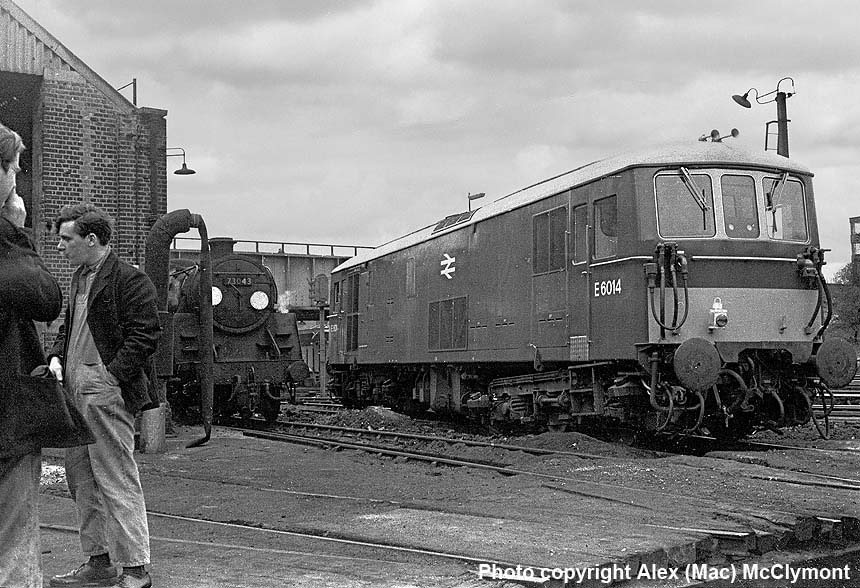
(Above-Below) Fireman Ken (Duke) Earle is in conversation with another member of staff as we wait for the breakdown crane to assist in the re-railing of Type (JB) electro-diesel locomotive E6014 at Guildford MPD. My Driver had moved the locomotive from No. 2 road in the New shed across the turntable onto the New Pit and as the trailing bogie came off the turntable, she suddenly lurched and the rear bogie dropped into the pit. Someone (who will remain nameless) had forgotten to utilise the securing pin at the end opposite the controls of the turntable and as the rear bogie approached the rail joint, the turntable slewed round causing the rear bogie wheels to become derailed. Note the paraffin tail lamp on the rear of E6014. Even in 1967, they were still the only guaranteed form of rear indication and electrically lit red blinds were still not recognised as being an efficient warning. It was thought that in the event of a complete failure, the locomotive's battery could still expire leaving nothing to warn other Driver's of the presence of the locomotive in an emergency. (Below) N15 Class 'King Arthur' 30796 ' Sir Dodinas Le Savage' approaches Woking Junction with a Up Local Passenger Service from Basingstoke to Waterloo in April 1962.The class didn't have much longer to live after this photograph was taken and only one of these fine locomotives survives - 30777 Sir Lamiel - which incidentally was the first locomotive that I 'cabbed' as a young spotter at Woking station in 1958.
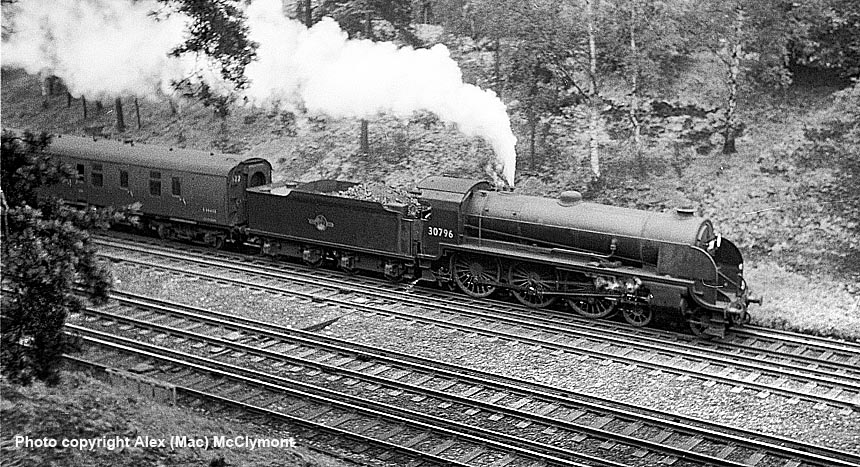
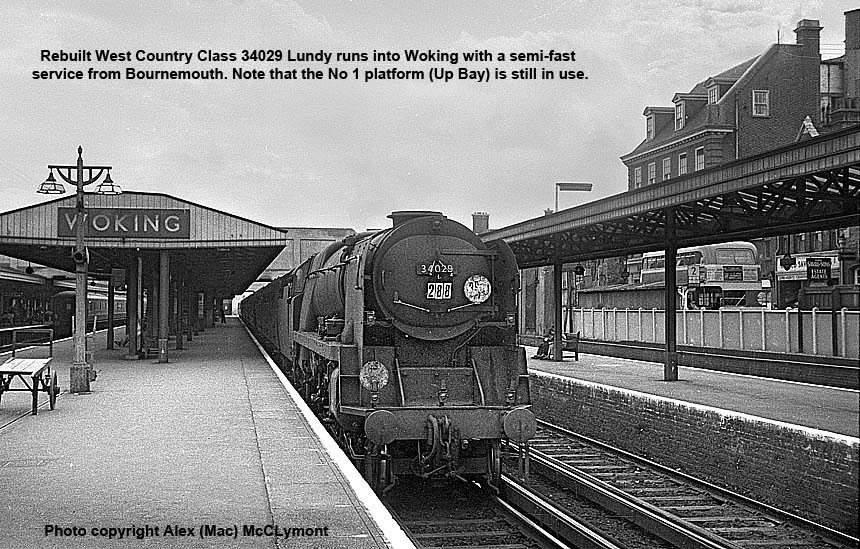
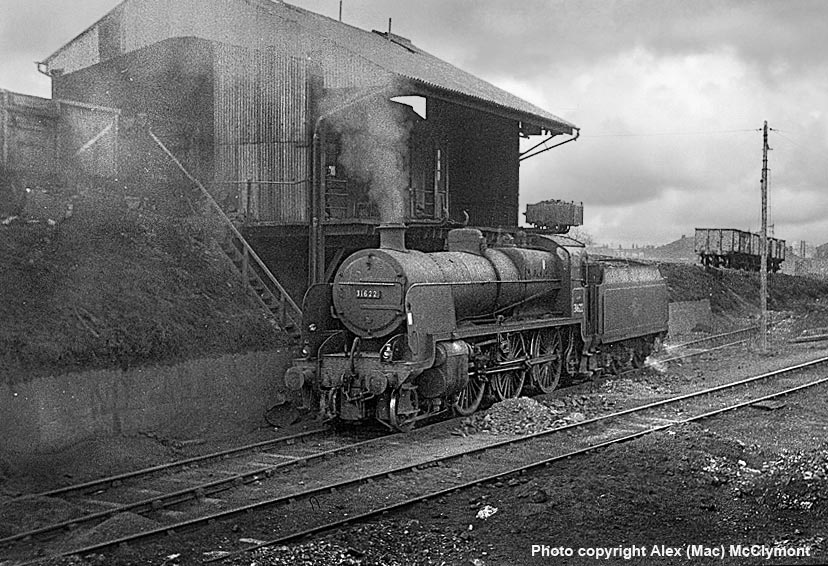
(Above-Below) U Class 31622 stands under the coal shute at Redhill Loco in 1961. These locomotives were predominantly utilised to work the stopping passenger services on the Reading-Redhill-Tonbridge lines. 31622 was withdrawn from service in October 1963 and scrapped at Eastleigh the following year. (Below) Nine Elms MPD and Rebuilt West Country Class 34018 'Axminster' looks resplendent as she is prepared for her next turn of duty in 1962. A Nine Elms based locomotive (70A) she was highly regarded by Drivers and firemen alike. Ending her days on July 9th 1967, she ran light to Salisbury from Guildford MPD to await her demise in John Cashmore's scrapyard Newport.
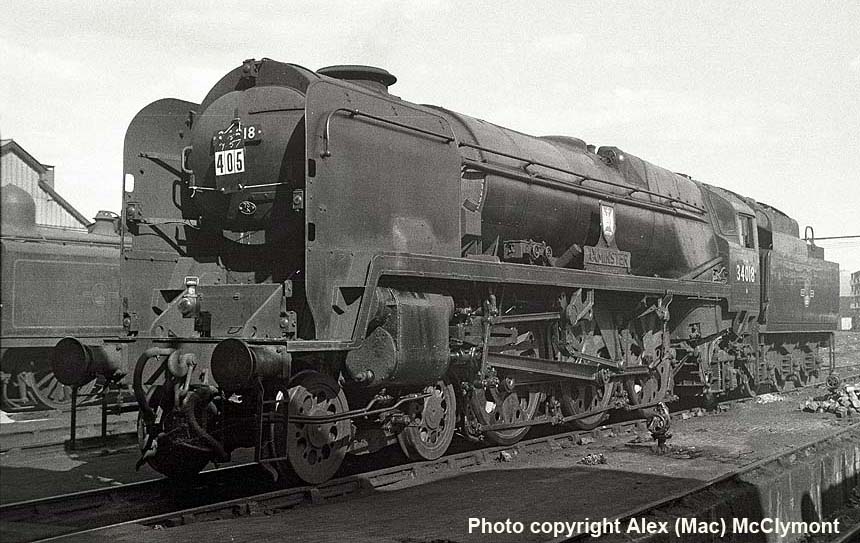
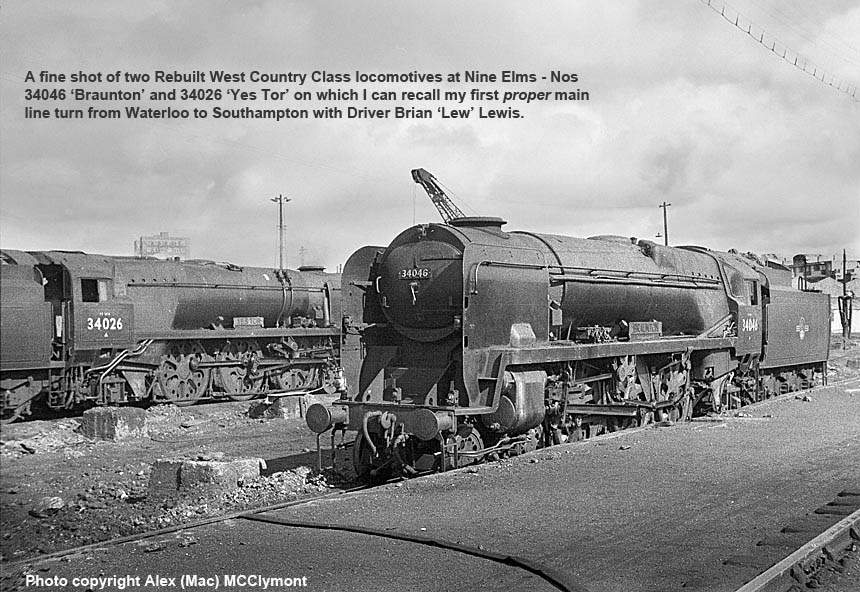
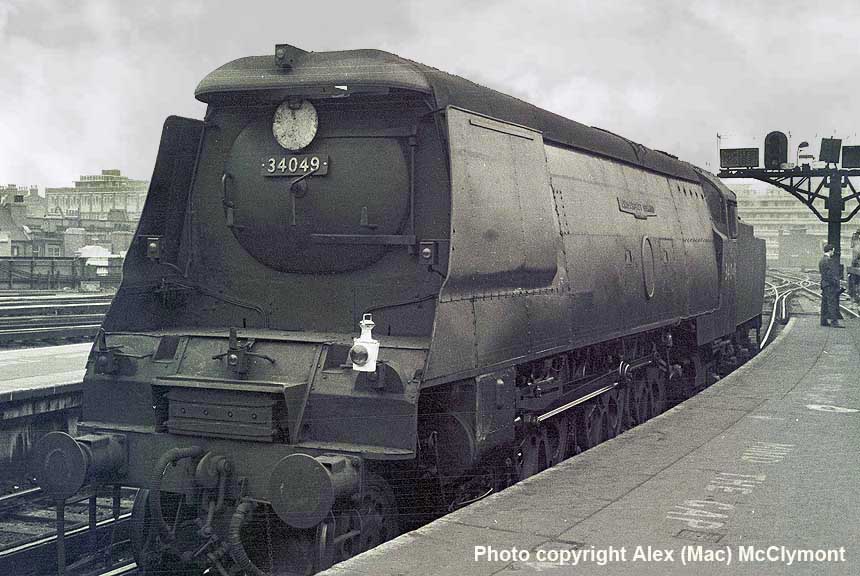
(Above-Below) Unrebuilt Battle of Britain Class 34049 'Anti-Aircraft Command' waits for the signal at the end of platform 9 at Waterloo to run light to Nine Elms MPD for disposal. Looking at the partial headcode on the smokebox, I think that the fireman has removed one of the disc boards from the left buffer beam and replaced it with a tail lamp indicating that she had arrived at Waterloo with a Boat Train from Southampton Old Docks. Withdrawn in December 1963, she was scrapped at Eastleigh Works in June 1964. (Below) An unknown 'named' BR Standard Class 5MT leaves platform 3 at Woking with a passenger train to Waterloo. Fireman Dave Cole from Basingstoke depot looks back to make sure everything is in order. Out of all the BR 5MTs allocated to the Southern Region 20 members had the honour of carrying the nameplates of the once-proud 'King Arthur' Class locomotives, namely: 73080 Merlin from 30740, 73081 Excalibur from 30736, 73082 Camelot from 30742, 73083 Pendragon from 30746, 73084 Tintagel from 30745, 73085 Melisande from 30753, 73086 The Green Knight from 30754, 73087 Linette from 30752, 73088 Joyous Gard from 30741, 73089 Maid of Astolat from 30744, 73110 The Red Knight from 30755, 73111 King Uther from 30737, 73112 Morgan le Fay from 30750, 73113 Lyonnesse from 30743, 73114 Etarre from 30751, 73115 King Pellinore from 30738, 73116 Iseult from 30749, 73117 Vivien from 30748, 73118 King Leodegrance from 30739 and 73119 Elaine from 30747.
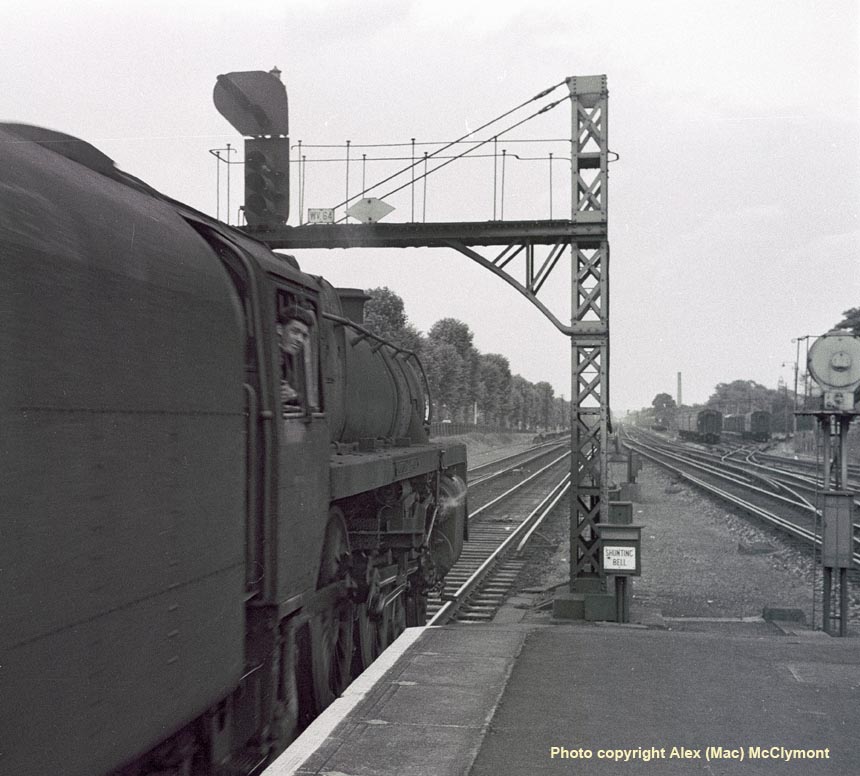

(Above-Below) On a Saturday evening in 1961, an Up Lymington-Waterloo Express approaches Woking Junction with V Class 'Schools' 30918 'Hurstpierpoint' in charge. With her safety valves about to blow, the fireman is working the injector to keep the pressure down. The locomotive's tender seems to have undergone a recent welding job probably caused by a minor collsion with another locomotive left foul. (Below)The same train with a view towards Woking Junction and the signal is still at Danger, probably to allow a Portsmouth Express to cross the junction and proceed towards Woking and eventually Waterloo.In the foreground, piles of small stone chippings (Meldon Dust) can be seen. Small amounts were packed under the sleepers to allow minute adjustment to the track.
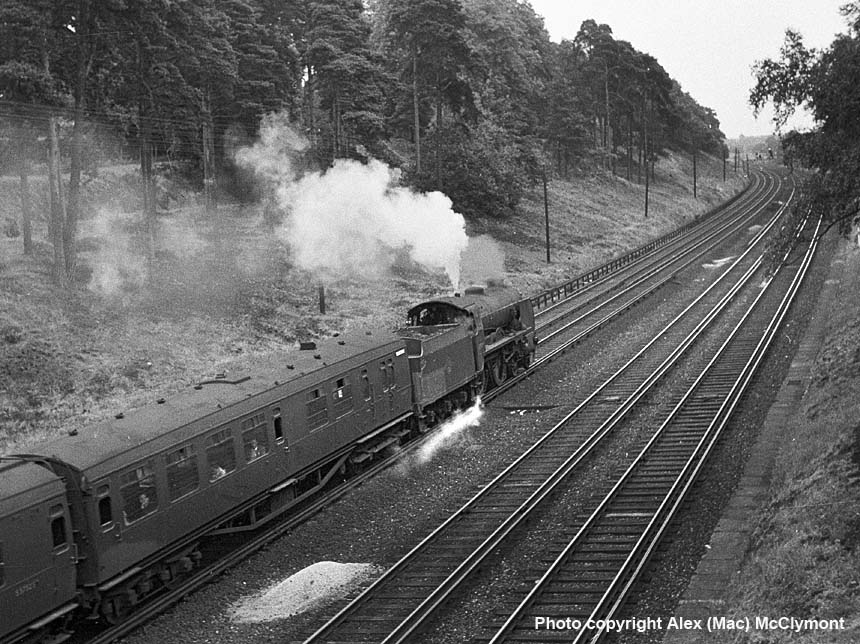

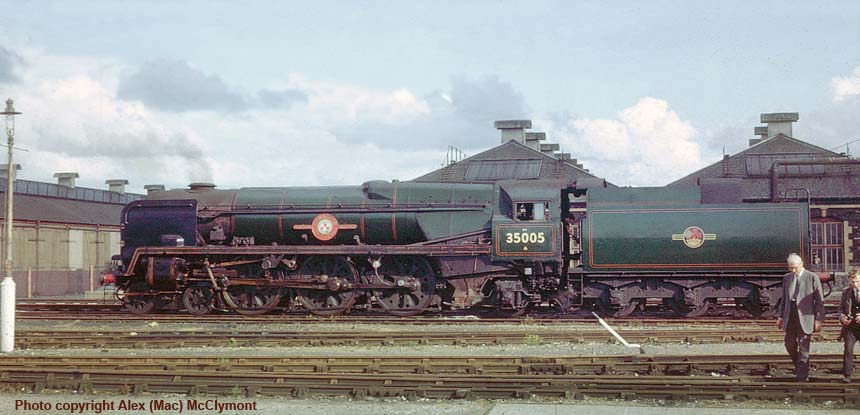
(Above) Rebuilt Merchant Navy Class 35005 'Canadian Pacific' languishes in the sunshine on an Eastleigh open day in the early 1960s. 35005 was saved from the scrapyard and is owned by the Mid Hants Railway and is at this moment at Eastleigh Works (her birthplace) undergoing a major overhaul.
FOOTNOTE: The World Wide Web is a major source of reference that draws thousands of enthusiasts every day, either to research a subject or to bring with them their own diverse interests and expertise; indeed the subject of trains and railways is extremely complex and so it is essential to get the facts right. Daniel Holden left a message on the Guest Book page; he writes - 'The picture alluded to be of 35005 at Eastleigh is in fact at Swindon in May 1965. I was on the trip and took a similar photo....' Thanks Daniel
 (Above-Below) Hornby 'Merchant Navy' class...just like the real thing! (Below) Someone is having a rest in the fireman's seat of BR Standard Class 3MT 77014 as she stands in the Coal road at Guildford. 77014 had previously been shedded at Blaydon (52C) and then North Blythe (52F) and had arrived at Guildford MPD on 17th March 1966. I didn't find her to be a particularly good locomotive; she leaked like a sieve and consequently wasn't free steaming. Such is the quality of Mac's photos I am able to reproduce just a small portion of the image. Click here to see a close up of the Blacksmith's Shop with windows wide open and a range of tools hanging on hooks.
(Above-Below) Hornby 'Merchant Navy' class...just like the real thing! (Below) Someone is having a rest in the fireman's seat of BR Standard Class 3MT 77014 as she stands in the Coal road at Guildford. 77014 had previously been shedded at Blaydon (52C) and then North Blythe (52F) and had arrived at Guildford MPD on 17th March 1966. I didn't find her to be a particularly good locomotive; she leaked like a sieve and consequently wasn't free steaming. Such is the quality of Mac's photos I am able to reproduce just a small portion of the image. Click here to see a close up of the Blacksmith's Shop with windows wide open and a range of tools hanging on hooks.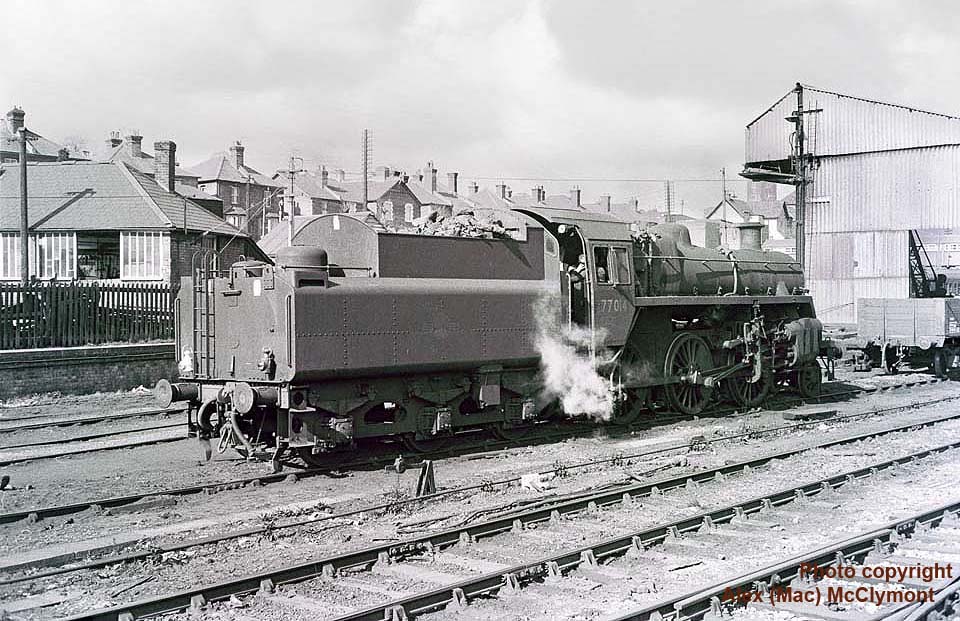
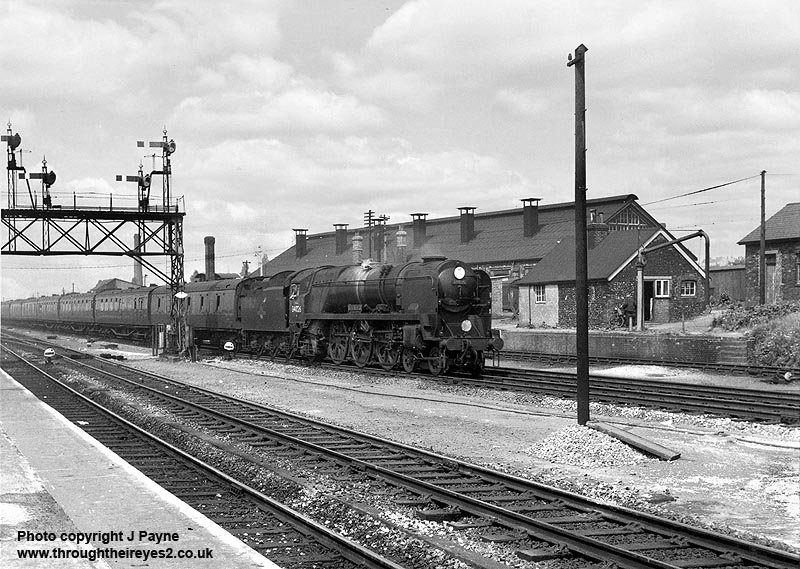
(Above) Rebuilt 'West Country' class 34026 'Yes Tor' seen here passing Basingstoke Loco with an Up Exeter-Waterloo express. The first time I worked an express passenger train on the main line as a fireman happened on a Sunday when I was booked on a spare 'as ordered' turn at Guildford. The Running Foreman came in and said they needed a crew to go passenger to Waterloo and work a Special train to Southampton and get relief there. My driver was to be Ray Beeson and he would be signing on later in the day at 3pm.
Well, I'm not sure why Ray didn't turn up that day but the job was given to Passed Fireman Ted (Lew) Lewis which I was quite pleased about. We caught the train to Waterloo and relieved the crew. The locomotive, Rebuilt West Country Class 34026 'Yes Tor' (having being prepared at Nine Elms) was already attached to the train. It was completely dark by the time we left and although I'd worked on Bulleid Pacifics in the past, it had only been on light engine trips.
However, as I remember, everything went according to plan, the locomotive steaming well in response to my firing technique (more luck than judgement) until we were checked for signals at Allbrook on the approach to Eastleigh. Brian started to apply the vacuum brake but found that he couldn't release it again and we came to an abrupt halt. We were both puzzled at first and wondered if someone had pulled the communication cord in the train. I thought that I'd better check the vacuum hose connection on the front of the locomotive and low and behold, found that it had come off the dummy housing. I quickly connected the vacuum pipe and could only surmise that the securing pin hadn't been utilised when used last and it wasn't until the vacuum was destroyed that the pipe had sprung away from its dummy housing. We arrived at Southampton a few minutes late but apart from that, it was a very memorable and enjoyable trip and the first of many Express non-stop trips to come!

(Below) The now-preserved N15 'King Arthur' Class 30777 Sir Lamiel is coming out of Basingstoke sidings past the Engine shed with ECS to work a stopping service from Basingstoke to Waterloo (one headboard on the left of the smokebox) maybe the 12.12pm or 13.13pm. Incidentally, this was the first locomotive that I ever cabbed as a 13 year-old boy in the late 50s. I was train spotting at Woking station and the loco was in the down bay. That's why she's depicted on the front cover of my book.

BRIAN DAVEY COLLECTION
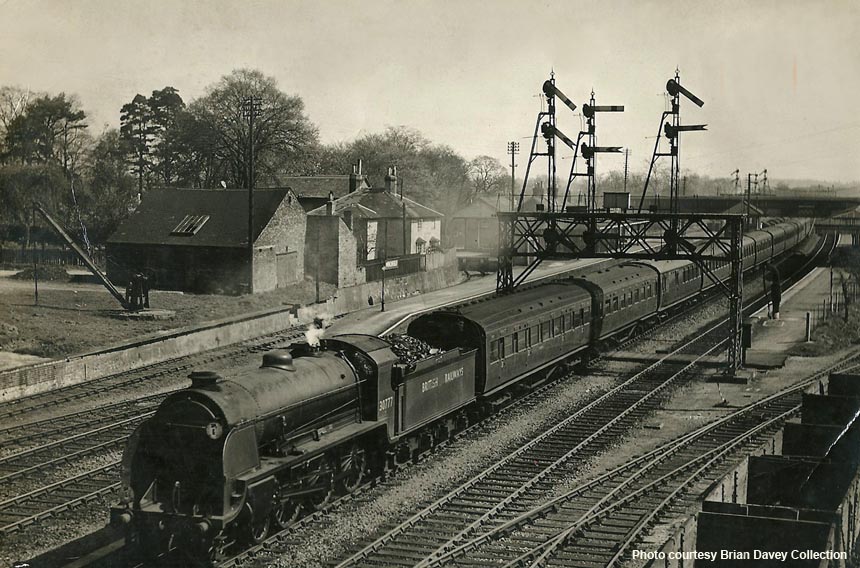
(Above-Below) Class N15 'King Arthur' 30777 'Sir Lamiel' again, this time hurtling through Winchfield with a Bournemouth Express passenger service from Waterloo. Semaphore signals in the area were lower quadrant and were pneumatically controlled by the signalman. Another fine feature in the photograph is the single jib crane on the up side siding. (Below) A view from the fireman's side of the footplate as Class V 'Schools' 30909 'St Paul's' leaves Wokingham and heads towards Reading with a passenger service from Guildford. Driver Brian Davey has let his fireman (Ernie Lee) perform the driving duties this day.
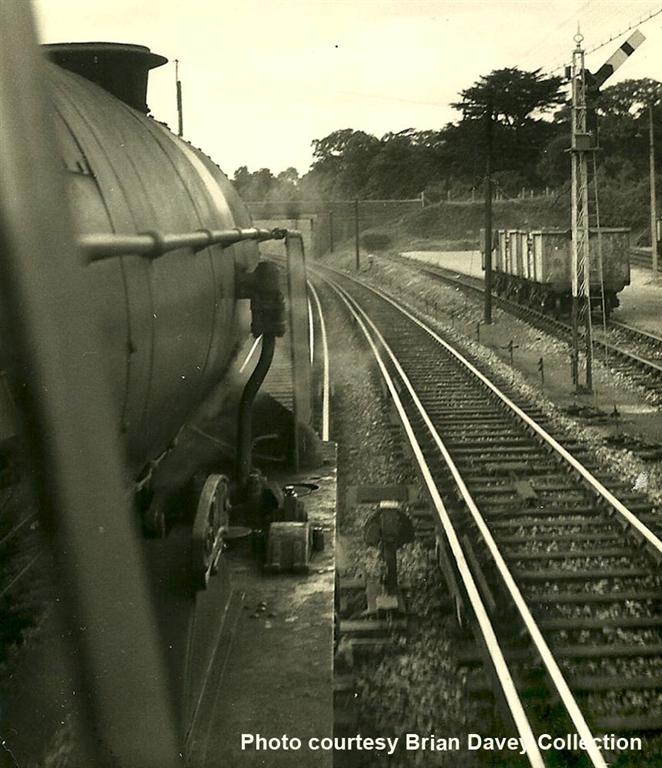
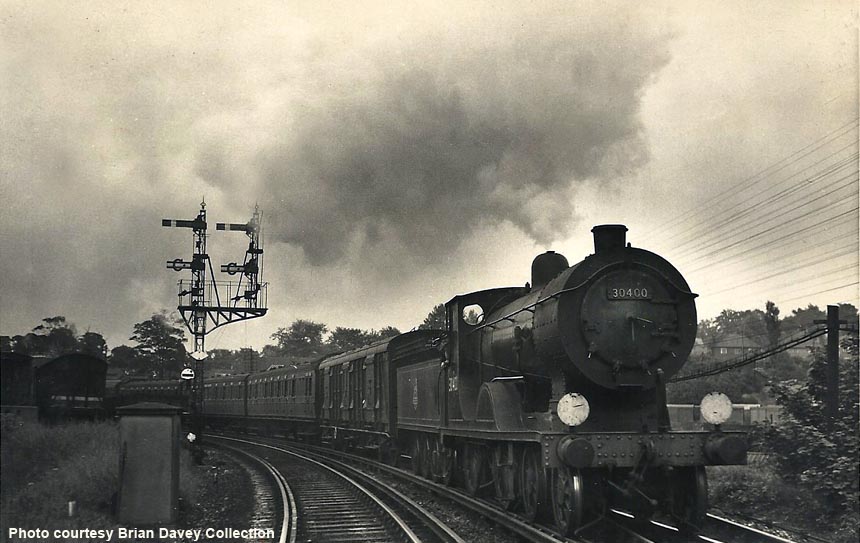
(Above) A superb shot of Class S11 30400 as she leaves Redhill with the 3.04pm passenger service to Reading on 19th July 1954. This was to be the last time that this type of locomotive was to work this train and was crewed by Guildford men Driver Bill Hedgecock and fireman Brian Davey.
BEN BROOKSBANK COLLECTION

(Above-Below) N Class 31862 waits in platform 6 & 7 (up the gulley) to work a passenger service to Reading in 1964. It was at this very spot that I jumped down to couple a loco to a train and my foot landed on the wooden boards guarding the conductor rail. I was extremely lucky not to have been electrocuted. Steam passenger services over the Reading-Redhill line only lasted another year and this same locomotive worked one of the final services (11.35am from Redhill to Reading) on Saturday 2nd January 1965. No 31862 was withdrawn at Eastleigh on 29th May 1965. The billboard on the platform is advertising the Revue Musical 'Six of One' at the Adelphi Theatre, starring Dora Bryan and Richard Wattis. (Below) A splendid view from Farnham Road Bridge in 1958 of 700 Class 30700 as she moves towards the coal stage and a London bound Portsmouth Express train comprised of 4-COR stock in number 6 & 7 platform waiting to leave for London. Also shown is Bulleid designed Austerity Q1 Class 33019 waiting for the signal at the end of platform 5 to allow it to enter the chalk tunnel and return to the loco shed.
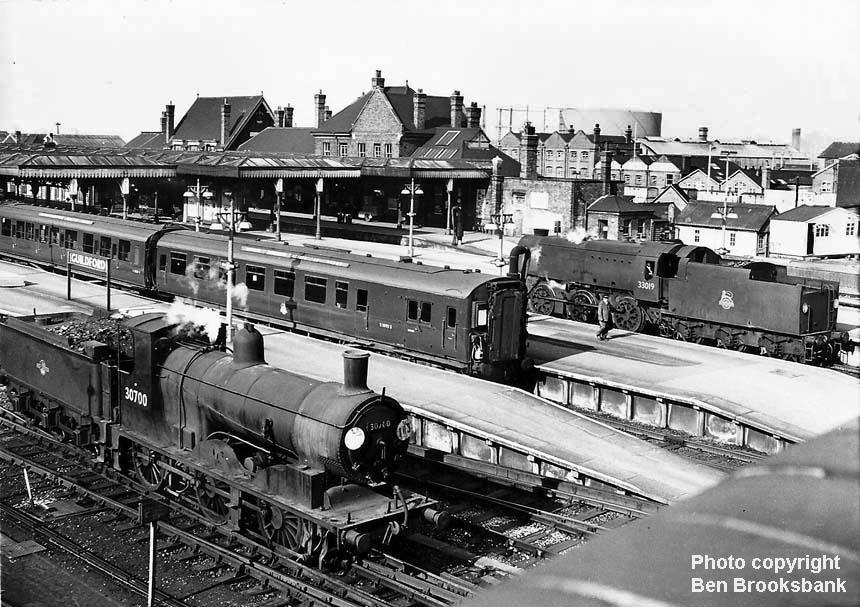
COLIN STACEY COLLECTION

(Above-Below) D1 Class No 31496 stands in the dock road by Farnham Road Bridge Guildford in 1954. This loco was withdrawn from service on 31st August 1955. Another member of this class (31737) was withdrawn from 70C in November 1956 and is now preserved as part of the National Heritage Collection at York Museum (Below) A superb shot of 30458 'Ironside' taken in 1951. Built by Hawthorn Leslie in 1890, she originally worked at Southampton Docks and Pier. She was later transferred to Guildford to be used as their shed pilot locomotive until withdrawn in 1954 when she was replaced by B4 Class 30086.
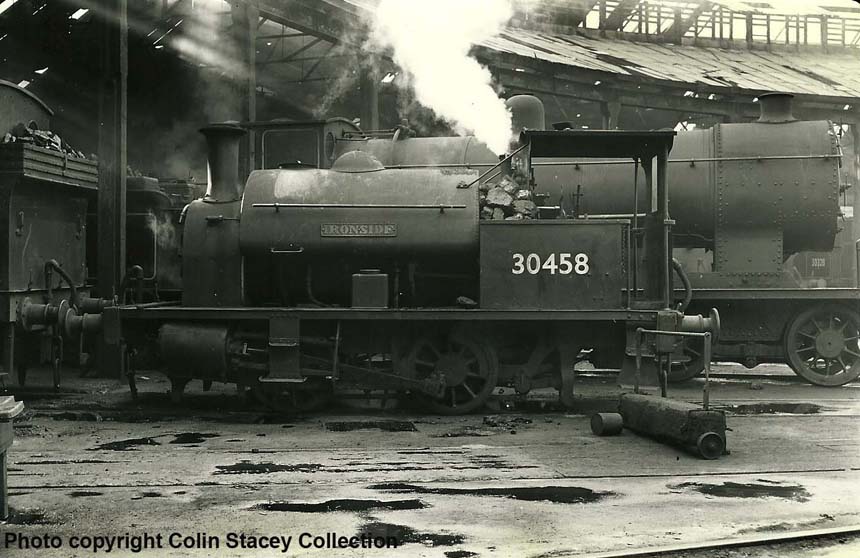

(Above) Ali Raschid recently sent me this tale about his daredevil train spotting exploits at Guildford loco. He writes - 'As a young schoolboy in Bermondsey, South London, we went on a school trip to Guildford. I think it was sometime in the spring of 1967. On arrival we were supposed to make our way to the cathedral, but told that if we got separated from the main party we were to meet back at the coach at the allotted time. Myself and a mate being train spotters immediately got separated (by dodging round a corner) and made our way to Guildford MPD.
We tried route one but couldn't get in without a permit. So as usual it was route 2. We were masters of 'bunking' over the wall at Nine Elms, virtually every Sunday. Guildford however was going to be a real challenge, since it was nestled into a cliff face. Incredible (and as dangerous), as it may sound, we went up onto the grass on the cliff at the back of the depot. We found an old rusty ladder which we bridged across onto the roof of the depot and crawled across. It still makes me shudder. It was pouring with rain and we were ankle deep in water in the valley gutter of the roof and we came down a roof access ladder and we were in!
I can only remember two locomotives actually in the shed. These were USA Class 30072 and I am pretty certain - Rebuilt Merchant Navy Class 35012 'United States Lines', which was on the far left road, when facing the shed. We then made our way round to the side under the bridge to the coaling area by the station (with hindsight that was the way we should have got in), where there were numerous standard class locomotives, presumably withdrawn, including a great 'cop' 77014. Sadly, no Maunsell locomotives were present. Still it was a fantastic memorable day, tinged with sadness being so close to the end of steam, which I will never forget...'
As you can see by the photograph (above) it was no mean feat to gain access to the shed in this way with the chalk cliff face proving to be a difficult and challenging hazard. Interestingly, other features shown in the photograph are the water tower (which fed all the water columns in the area), the staff canteen which was situated next to the Farnham Road, the bike shed, situated at the top of the concrete steps that led down to the loco, the Orphanage Hut, situated alongside Guildford Park Road and the Breakdown crane standing in the road between the shed and the running line. (Below) Another fine view taken in 1953 of the various small buildings that surrounded Guildford Loco especially the propped garages that were at the back of the houses in Guildford Park Road. U Class 31625 stands in the dock in front of the Blacksmith's shop with M7 Class 30028 beside it.
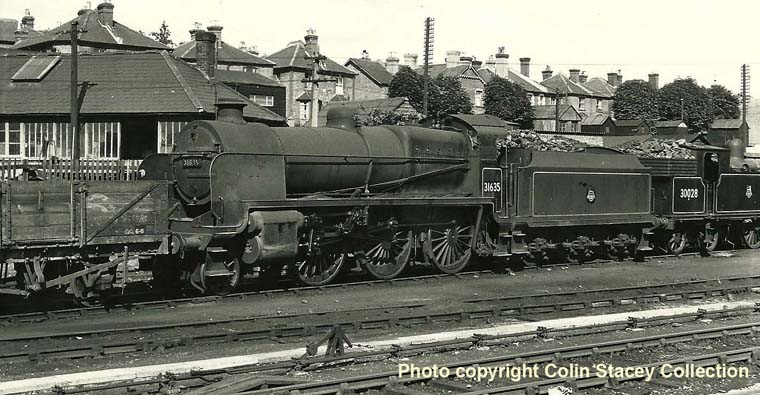
DAVID CHRISTIE COLLECTION

(Above-Below) USA Class 30072 and Q1 Class 33004 wait below the Shedmaster's office for entry into Guildford Shed in 1964. The canteen that was situated behind the bike shed has been demolished but the Driver's Cabin with flat roof and stovepipe chimney can just be seen above the ash wagon. (Below) A fireman holds the pipe in to take water on N Class 31866 before dropping down to take coal at Guildford Coal stage in 1964. The garages on stilts can be clearly seen on the right of the photograph as can the Orphanage Hut at the top of the photograph.
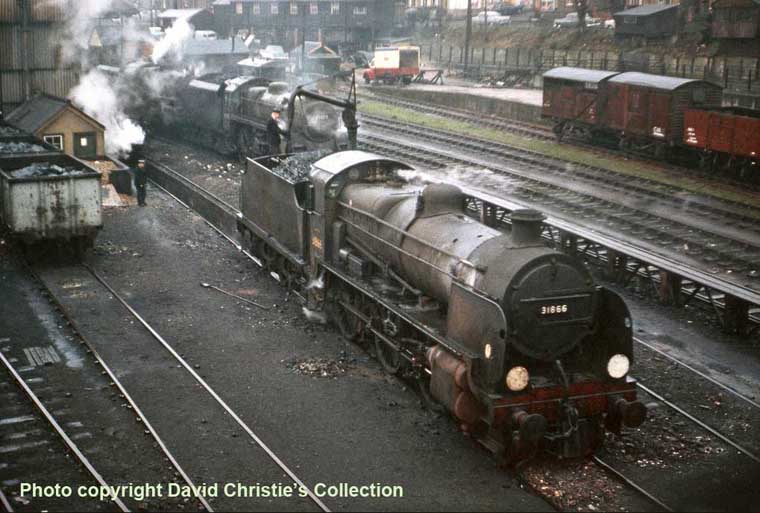
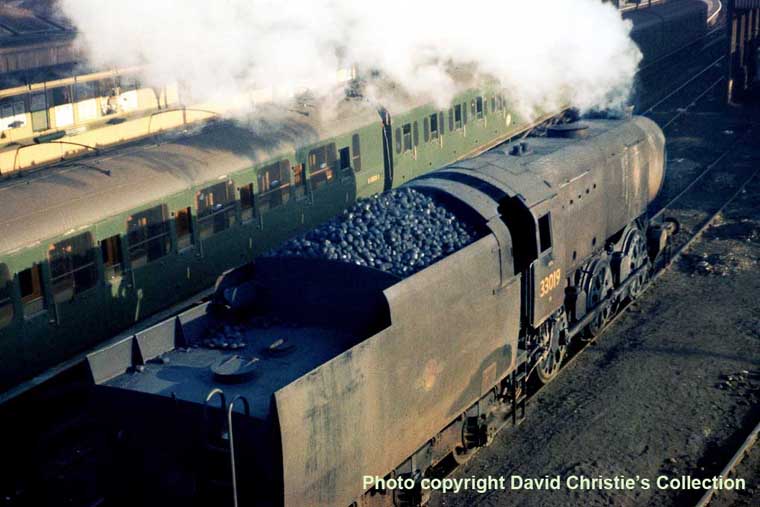
(Above-Below) Q1 Class 33019 moves onto the Coal Road at Guildford in October 1963. The coal on the tender is of the 'briquette' form - coaldust bound together with a form of cement - sometimes more cement than coal! These were commonly known as 'eggs' and when the locomotive was at speed, the briquettes would roll off the shovelling plate and end up all over the footplate floor! Apart from that, they made a lot of ash and the dust from the briquettes would irritate your eyes especially when running tender first. (Below) A horribly wet day but locomotives still had to be coaled and watered. S15 Class 30844 stands in the Back Road of the Coal Stage and an unidentified N Class stands on the Coal Road. There's also plenty of rain water on number 7 & 8 platforms too which provide interesting reflections to this photograph.
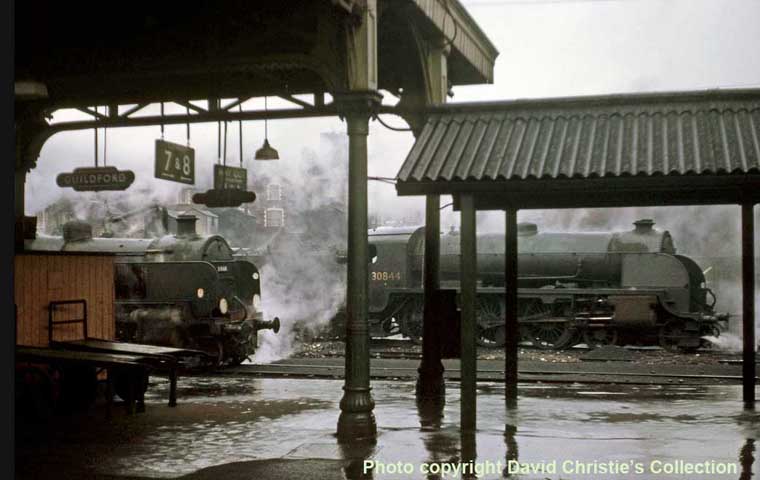

(Above-Below) A sunnier day this time as Q1 Class 33035 with cylinder cocks open, makes her way past the Coal Stage at Guildford on 31st August 1963. Unusually, for a Saturday, Guildford's platforms are completely devoid of passengers. (Below) Driver George Powell of Reading waits for the road at Guildford with U Class 31623 on Saturday 31st August 1963. The fireman is a Guildford man (Ken Earle) who was probably booked on loan to Reading this day. The letters 4P 3F denote the power class of the locomotive - Class 4 Passenger and Class 3 Freight work.
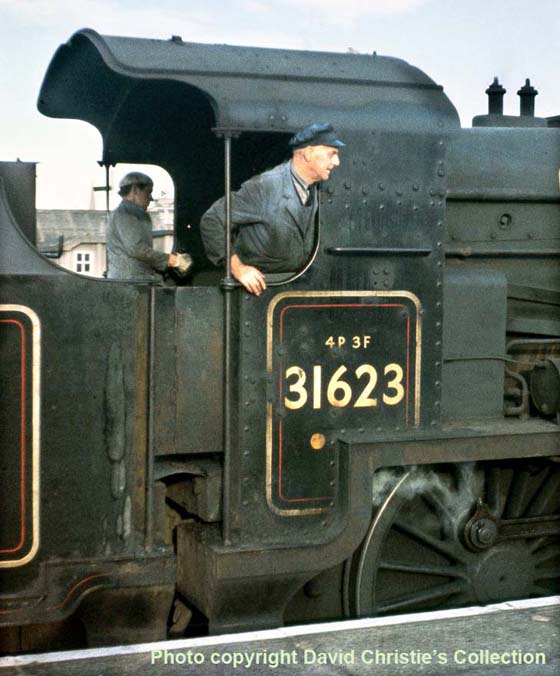
(Below) A fireman replenished the water tanks of BR Standard Class 4MT 80148 as N Class 31819 waits for her next turn of duty in the Back Road at Guildford Coal Stage in October 1963. The Coalman's hut is clearly visible between the two locomotives. The photos shown here can be found in David Chrstie's excellent Flickr Photostream of Sixties steam and diesels. Bus enthusiasts are well catered for too! A visit to his Flicker website is highly recommended...click here.
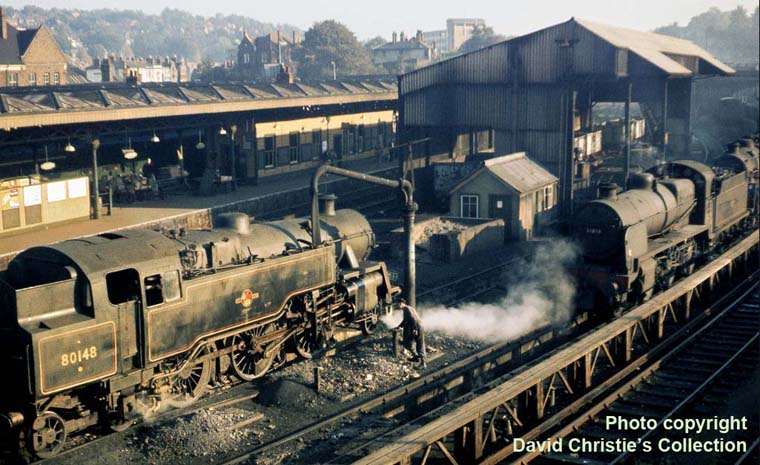
The Bordon Brigands
by Pat Kinsella.
During steam days, working passenger and freight trains on the main line could be very exciting and even exhilarating at times, but there were anxious moments too. Guildford shed was the home to several elderly locomotive classes including some pre-Grouping types, consequently their steam pressure gauges often
 displayed an aversion to indicate even a hint of high pressure and the water level in the gauge glasses bobbed tantalisingly near the bottom nut. So no, it was not all beer and skittles on the footplate, especially for the fireman, who, if forced to stop on the running line short of steam knew that it put him in peril of having his reputation tainted for his entire career.
displayed an aversion to indicate even a hint of high pressure and the water level in the gauge glasses bobbed tantalisingly near the bottom nut. So no, it was not all beer and skittles on the footplate, especially for the fireman, who, if forced to stop on the running line short of steam knew that it put him in peril of having his reputation tainted for his entire career. I remember one occasion on a cold dark autumn night working a heavy freight from Eastleigh to Woking with a forty year old 'S15'. The trip included the eighteen mile gradient between Eastleigh yard and Lichfield Tunnel, and we were not getting on at all well on the incline, however luck was on our side when the signalman turned us into Wallers Ash siding to allow a passenger train to pass - 'We'll have time to recover a bit when we reach the end of the siding at Weston,' called out my driver, his eyeballs looking very large in the glow from the gauge lamp flame.Plodding up the rising gradient at a walking pace over the one and a half mile long siding we eagerly awaited our arrival at Weston. Our loco had been in traffic for six or seven hours without the fire being cleaned. By this time clinker had accumulated to about six inches in depth and that prevented primary air reaching the fire (the same effect as shutting the dampers). Use of the fire irons, especially the 'dart' to break up the clinker was only a temporary measure. In effect the fire would have to wait to be cleaned properly in a depot or siding to achieve complete combustion again, hence the continual struggle on to Woking. We were about a hundred yards from our 'stop signal' when we heard the plaintive moan of a Merchant Navy whistle as it rapidly overtook us on the main line hauling a Bournmouth to London express, the driver thereby signalling to us that we had cramped his style and probably made him a couple of minutes late. Accelerating aggressively the glow from the condensation-covered train windows flashed past in seconds while the paraffin tail lamp on the rear coach glowed brighter than my fire. The sudden cold draught forced into our open-ended cab from the fleeting leviathan only inches away made me stifle a shudder.
My driver simply had to shut off steam for us to clatter to a halt but as he did so the express had passed through the section ahead and our signal cleared for us to proceed back onto the main line behind it. Bugger! No time to recover. Nothing for it, just get the fire irons down again, keep plodding on and endeavour to preserve my standing as a fireman.
Well of course, there were two sides to working steam trains; it didn't always have to be the excitement, sweat or anxiety of main line work and the contrast couldn't have been greater. Diverting onto a single line after collecting the 'staff or token' from the signalman was akin to getting the key to the 'Tardis', we entered a time warp where life slowed almost to a standstill emphasised by the greatly reduced speeds of these severely restricted routes.
In the late Fifties and early Sixties, Guildford locomotive such as 700s built in 1897, Eastern Cs built 1900, M7s built 1897 and even 0395s built 1881, were still performing sterling service on travelling shunting duties, invariably stopping here, there and everywhere to detach, shunt and attach mixed traffic wagons as required. Lines such as; Tongham, Meon Valley, Mid Hants, Horsham, Bisley and Bordon were regularly visited by these locomotives.
Take the Bordon single line branch from Bentley on the Alton line, a Push-Pull passenger service operated here, involving a Drummond air braked M7 class (Motor Tank) locomotive, fitted with a donkey pump (steam
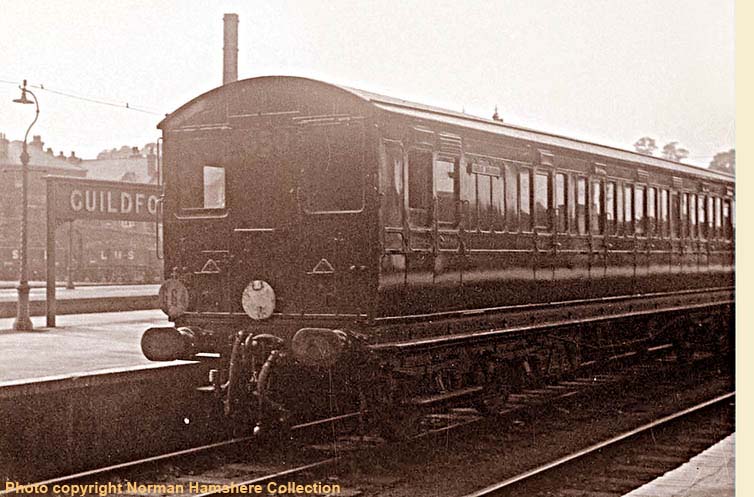 driven air compressor) either pushing or pulling a two-car set of coaches especially adapted for these services. Only experienced firemen were permitted to work push and pull trains because when pushing from 'A' to 'B' they worked alone on the locomotive as the driver would be driving from the leading coach (see photo left). This was made possible because the driver had control of the brakes and regulator via a series of coupling arms and air pipes connected between the locomotive and the driving cab of the leading coach. It was the habit with most crews to 'leave the pin out' as they used to say, i.e. not connect up the regulator and let the fireman use his knowledge of route to apply and shut off steam as he thought fit while the driver used the brake his end. I'm reliably informed by more senior retired drivers that having the 'pin in' resulted in very erratic movement of the regulator (by compressed air) making the admission of steam to the cylinders capricious.
driven air compressor) either pushing or pulling a two-car set of coaches especially adapted for these services. Only experienced firemen were permitted to work push and pull trains because when pushing from 'A' to 'B' they worked alone on the locomotive as the driver would be driving from the leading coach (see photo left). This was made possible because the driver had control of the brakes and regulator via a series of coupling arms and air pipes connected between the locomotive and the driving cab of the leading coach. It was the habit with most crews to 'leave the pin out' as they used to say, i.e. not connect up the regulator and let the fireman use his knowledge of route to apply and shut off steam as he thought fit while the driver used the brake his end. I'm reliably informed by more senior retired drivers that having the 'pin in' resulted in very erratic movement of the regulator (by compressed air) making the admission of steam to the cylinders capricious.Prior to the demise of steam in 1967, enginemen enjoyed a certain amount of independence and self regulation, there being a distinct 'Titfield Thunderbolt' atmosphere and attitude to life particularly on branch lines. The experience gained in working over such metals gave locomotive crews a vast knowledge of where game, such as pheasant, partridge or hare, plus pigeon and rabbit were to be found. To this end
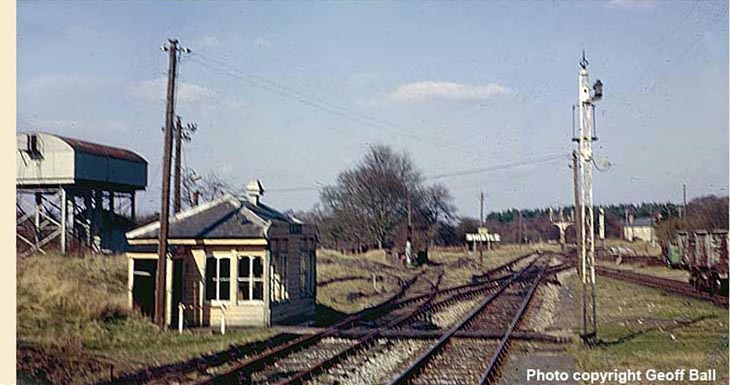 some drivers and guards carried shotguns to work with the intention of shooting a dinner or two while travelling in one direction then picking up their quarry on the return journey. It must have been great sport attempting to shoot mobile game while on the move oneself, rather like shooting buffalo at the gallop in Cowboys and Indians films. Regular travellers would of course have become familiar with this arrangement but as long as they made their connection with the 'London' at Bentley they would be quite happy.
some drivers and guards carried shotguns to work with the intention of shooting a dinner or two while travelling in one direction then picking up their quarry on the return journey. It must have been great sport attempting to shoot mobile game while on the move oneself, rather like shooting buffalo at the gallop in Cowboys and Indians films. Regular travellers would of course have become familiar with this arrangement but as long as they made their connection with the 'London' at Bentley they would be quite happy.One day in the early fifties Guildford driver, Herbie Churchill, was rostered a turn of duty on the Bordon to Bentley Push-Pull service, and in order to acquire his next day's dinner he had an arrangement with the guard for him to bring his shot gun to work with him. The next morning, as they departed Bordon in push mode for the four and a half mile journey over the single line to Bentley, the fireman was undertaking his duties responsibly on the air braked fitted M7 locomotive on the rear, while Herbie was driving from the leading coach with the train guard in the cab with him.
Once clear of the station and steaming along at a respectable twenty five miles an hour towards Kingsley Halt, Herbie was admiring the loaded shotgun and making ready to shoot anything that moved when it
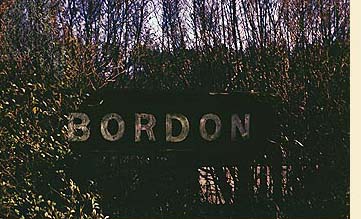 accidentally discharged and the shot penetrated the thin partition between the cab and the first passenger compartment immediately behind them. Sitting in the compartment with his back to the driving cab, a passenger, I believe he was a member of staff, a permanent way man, was blissfully unaware of the unfolding drama until he received the force of the blast at close range.
accidentally discharged and the shot penetrated the thin partition between the cab and the first passenger compartment immediately behind them. Sitting in the compartment with his back to the driving cab, a passenger, I believe he was a member of staff, a permanent way man, was blissfully unaware of the unfolding drama until he received the force of the blast at close range.Realising that someone had been quite badly hurt, Herbie stopped the train, then changing ends ran back to the locomotive and drove back into Bordon station, against the semaphore signals showing danger, shouting out to the signalman, George Bone, that they needed an ambulance as they passed his signal box.
Needless to say, driving back into the station against signals was against rules and regulations with the result that Herbie was confined to shunting duties at Guildford shed for a period of nine months.There is no mention in the 1950 black cover rulebook regarding the carrying of firearms on the footplate, so that's ok then.In later years it was forbidden to play a transistor radio on the footplate, but still no mention of shotguns.
In those days, now long gone, nearly all misdemeanours were kept 'in house', it was left to Shedmasters to apportion punishment as they thought fit and nine months shunting duties, I suppose, was considered reasonable for running past a red signal deliberately without permission, albeit in emergency.Incidentally, this was the only example I can recall of a driver so doing.
There was provision in the rule book (rule 37) to facilitate the passing of signals at danger listing thirteen occasions, known as the thirteen exceptions, for shunt purposes or times of crisis or equipment failure, but not one, believe it or not, as a consequence of shooting staff and passengers!
Footnote; I don't have any information on injuries received by the 'platelayer' but presumably they were not too severe and he didn't press charges. It is more than likely that Herbie would have known him because enginemen and linemen usually had a good relationship on branch lines, until this near-fatal shooting incident anyway; for example; being able to swap items such as coal in exchange for bean sticks which were picked up at pre-arranged locations. A dozen fresh eggs in exchange for a hundred weight of 'best Welsh' delivered at a lineside cottage was considered a reasonable exchange. Other times linemen were given a lift to their place of work to save a long walk and would be picked up again at the end of their shift making an early finish possible for them. As an afterthought; perhaps Rule 234 clause 'g' should have been amended for 'lookout men' at site of work to shout 'take cover!' instead of 'stand clear' when 'Herbie' or his cohorts were passing on the Bordon shuttle!
(Below) A fine shot from Mike Morant's Collection of USA Class 30064 at Guildford working a leg of an RCTS special. Fireman Len Boxall has just replenished the tanks before they depart to Christ's Hospital via the Baynards-Horsham line. The locomotive had just worked the train from Woking where S15 Class 30839 had worked the first leg of the tour from Waterloo via Brentford, Ascot, Bagshot and Sturt Lane Junction East Curve; a 2-BIL 2117 waits in the Up Cobham platform 3 to work a slow passenger service to Waterloo via Woking. The next photo (below) shows the USA Class 30064 about to finish the first leg of the 'Midhurst Belle' Rail Tour at Christ's Hospital station on Sunday 18th October 1964. The group of railmen from left to right are: Driver Pat Warner, Traction Inspector Arthur Jupp, the Station Master and fireman Len Boxall. Mike Morant's knowledge of all things Southern is well known, and it was a sad day for SR enthusiasts when Mike's 'Old Pics Brought to the Fore' was lost following closure of Fotopic. However Mike continues to provide a valuable resource on the 'Southern E-Group' website here amongst others.
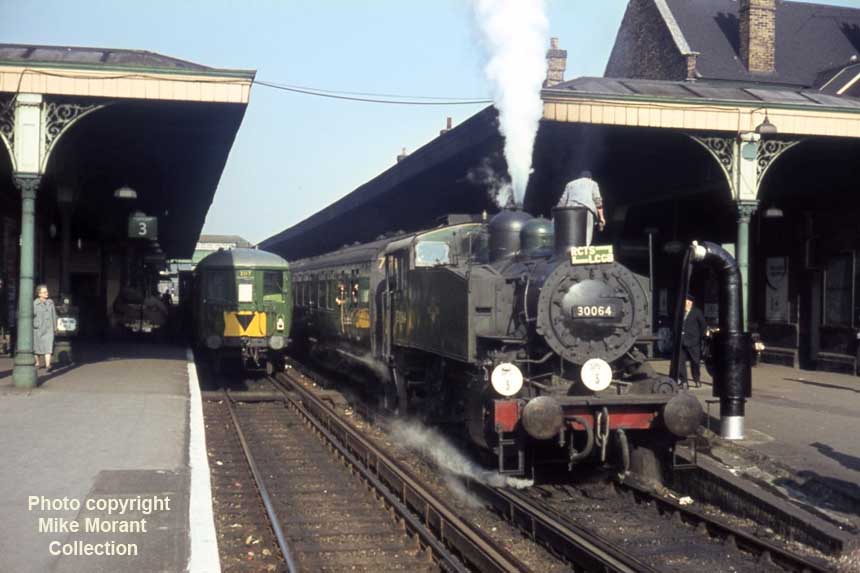
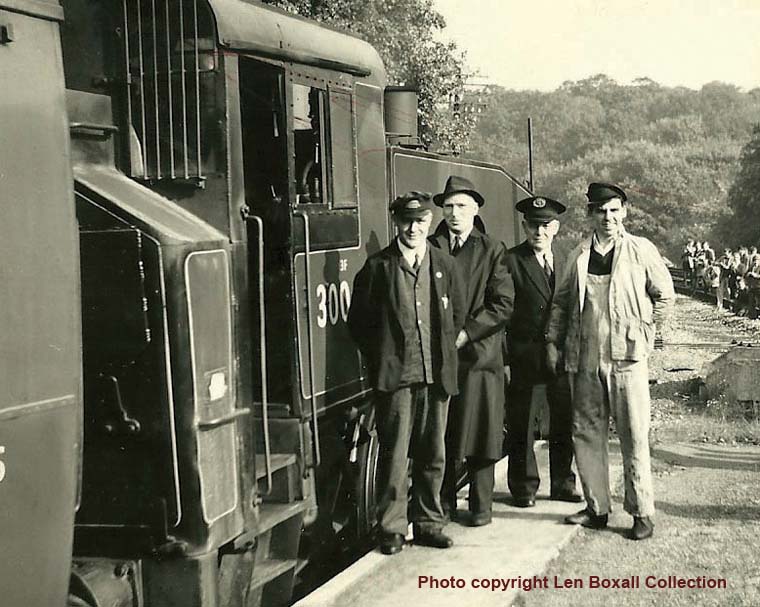
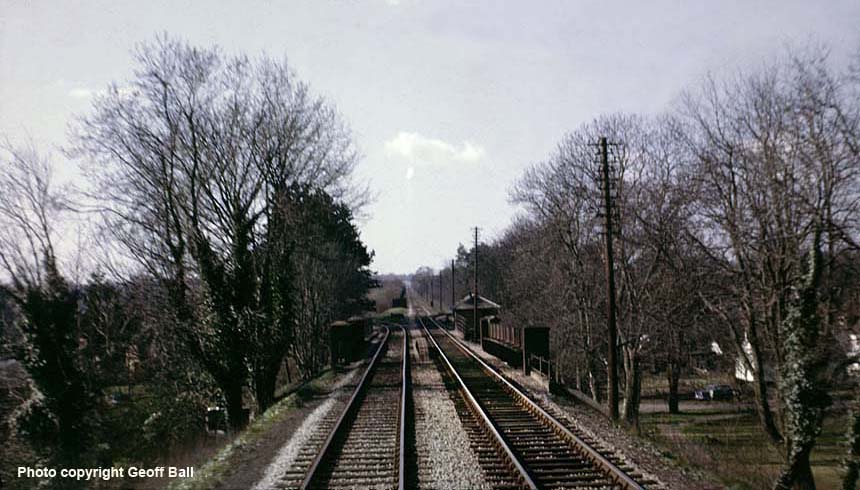
(Above) A view of the Meon Valley line at Butts Junction as it veered off towards Faringdon, Tisted, Privett, West Meon, Droxford, Wickham, Knowle Halt and Fareham. The Line had one crucial role to play in the D-Day operations. On Thursday, June 2, 1944, Winston Churchill, U.S. General Dwight D. Eisenhower, the Prime Ministers of Canada and South Africa, William Lyon Mackenzie King and Jan Smuts and other Allied Leaders met in a special train at Droxford Station (the train was actually the Royal Train from the London, Midland & Scottish Railway). The station possessed the longest siding in southern England (outside the railway works at Eastleigh) and was close to a deep cutting. If threatened by an air raid the train could be pushed into the relative safety of the cutting. During this meeting, final decisions regarding the planning of Operation Overlord were made.
NORMAN HAMSHERE COLLECTION
(Above-Below) SR 10 ton wagon with a couple of interesting labels - one belonging to a brick company and a poster depicting the Coronation of King George 6th dates this photograph circa May 1937. A partially hidden Dennis Brothers bus can be seen parked in the background. (Below) A horse drawn wagon depicting Chaplins Ltd - agents to the Southern Railway - displays an advert for Mansion Polish outside the entrance to Guildford railway station. A partially hidden Franks & Co Coal and Coke Merchant sign can be seen on the left of the photograph while someone in the background pastes another advertisement to a hoarding. The Railway Hotel entrance and sign can be seen on the right of the photo.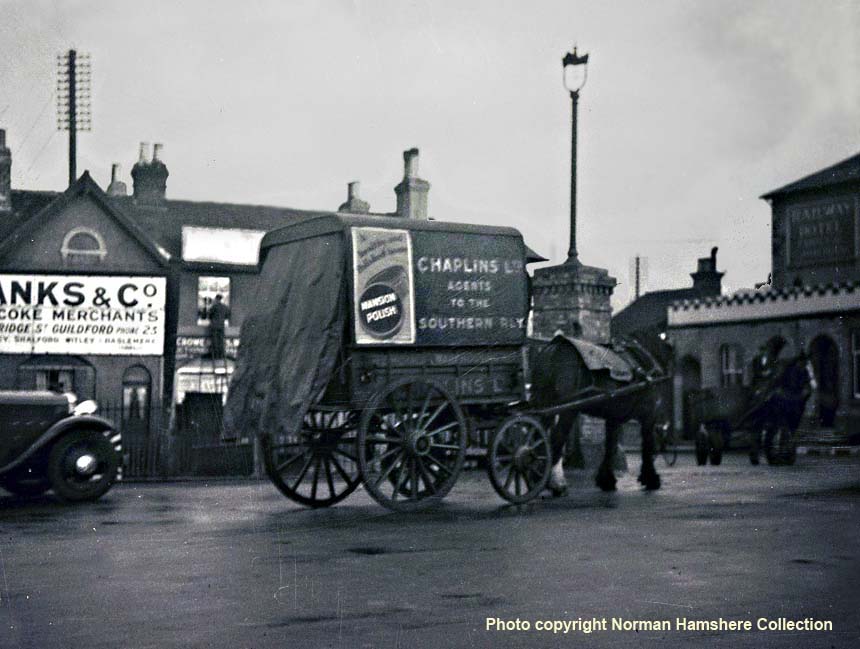
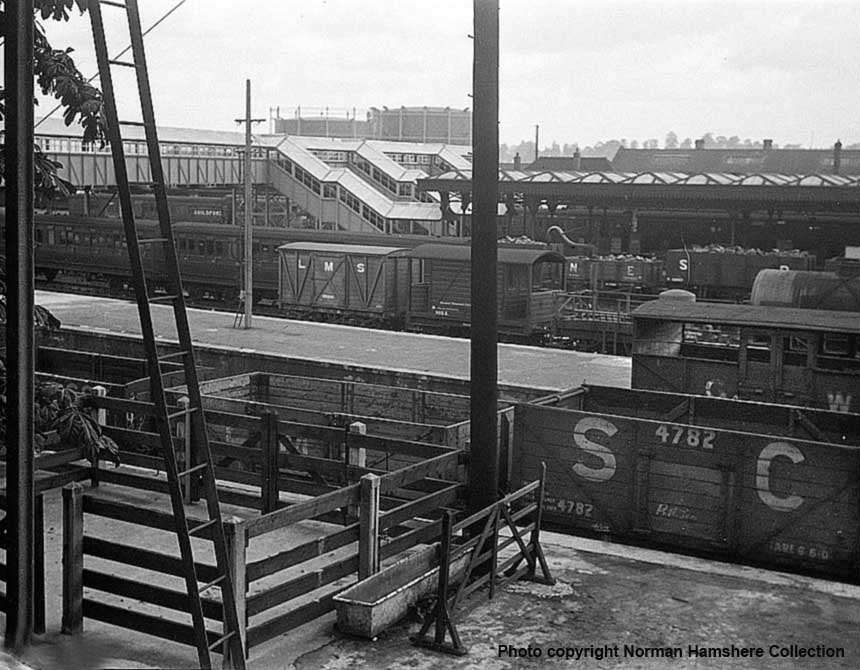
(Above-Below) Guildford Up Yard Dock showing the cattle pens and various types of rolling stock from different railway companies. The Passometer (footbridge) had recently been installed which gave access to the station from Guildford Park Road as well as the main entrance. Guildford's two gas towers can be seen in the background. (Below) A Stroudley D1 0-4-2T stands in the Back Road at Guildford Loco. Originally numbered 260 when built in March 1882 and at which time it was also named 'Lavington' but the name was removed around 1904/5. 260 entered SR stock in 1923 and would have had a 'B' prefix added to the number but from 1928 the 'B' was replaced on all ex-LBSCR engines with the number '2'. So, 2260 is the obscured digit hidden by steam. No. 2260 just survived WW2 being withdrawn in July 1946.

(Above-Below) The lower quadrant starter and distant signals are in the clear position for the Reading line as an SER Stirling B1 Class locomotive prepares to work a passenger service from Guildford for Reading. A lone milk churn and a very large wheeled barrow can be seen at the end of the platform and two of the chimneys of the local brickworks can be seen in the background. (Below) Southern Railway Horse & Cart No.68 waits patiently and the canopy advertisement says it all. The disenfectant was patented by John Jeyes in 1877 and the product was granted a Royal Warrant to the Brtish Royal Family in 1896. It continues to supply the Royal household to this day.
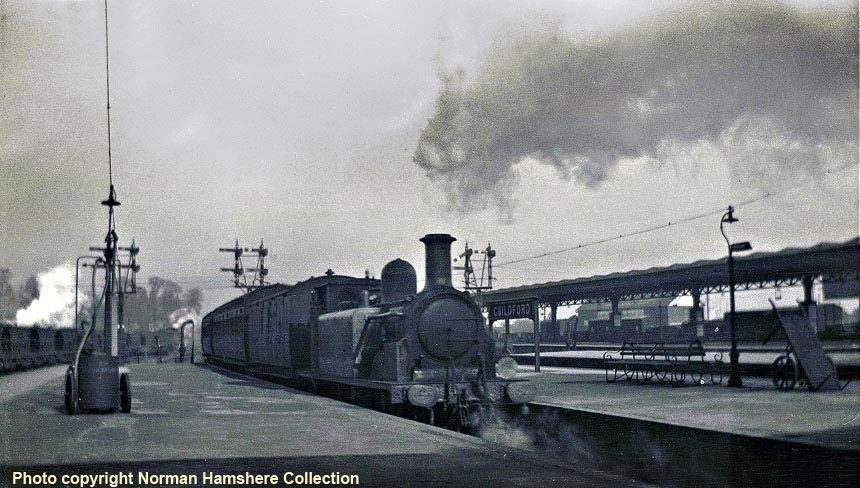
(Above-Below) Another Stroudley D1 0-4-0T No. 2290 but this time attached to a Push-Pull set shunting out of platform 6&7 at Guildford. A train made up of stone hoppers can be seen in the Up Yard and some form of water tank for replenishing the train toilets can be seen parked on the platform. (Below) Guildford Station's platforms were much shorter in the 1930s and a porter waits patiently with his loaded barrow at the crossing for a Push-Pull train headed by an M7 Drummond tank leaves platform 5 bound for Redhill. Note the short road leading to a stop block next to platform 6&7 - probably used for a standby locomotive if necessary. Another feature of Guildford station were the ornate cast iron stanchion pillars which allowed rainwater to flow from the station roof through their hollow sections to the track below.
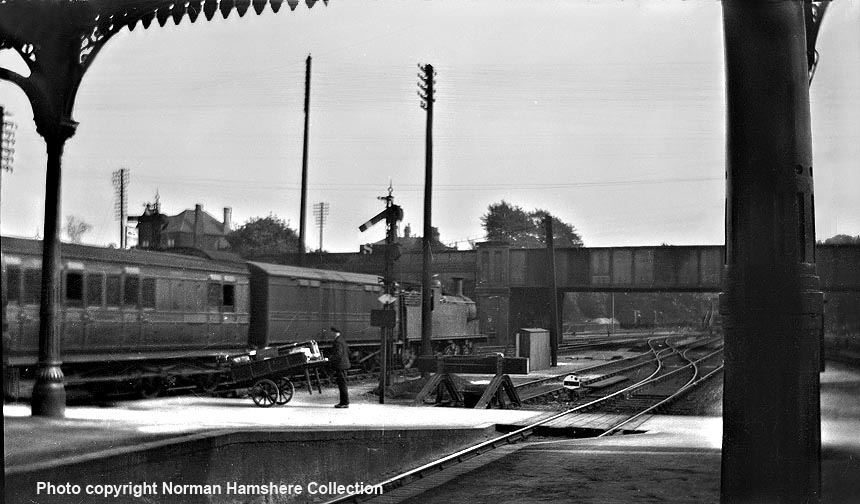
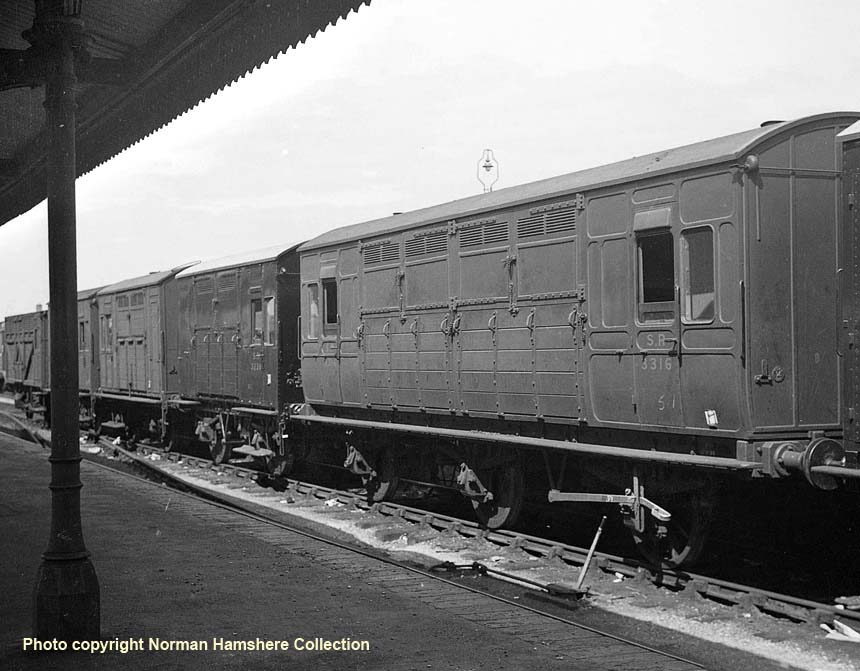
(Above) I know nothing about these vehicles except that they are standing in Guildford Down Yard, but it is an interesting shot and worth inclusion on this page...perhaps someone will have details? My thanks to Mike Morant for identifying some of the more obscure photos...

Geoff Burch's contact details can be found HERE.
Polite notice: All text and photographs are protected by copyright and reproduction is prohibited without the prior consent of the © owners. If you wish to discuss using the contents of this page the email address is below. Please note - this is not a 'clickable' mail-to link via Outlook Express. You will have to email manually.
dheycollection@ntlworld.com




